Tsukune are grilled Japanese chicken meatball skewers glazed in a delicious sweet-savory sauce. Typically served at yakitori and izakaya restaurants, these juicy and irresistible meatballs are easy to make at home with your oven broiler or grill. It’s hard to eat just one!
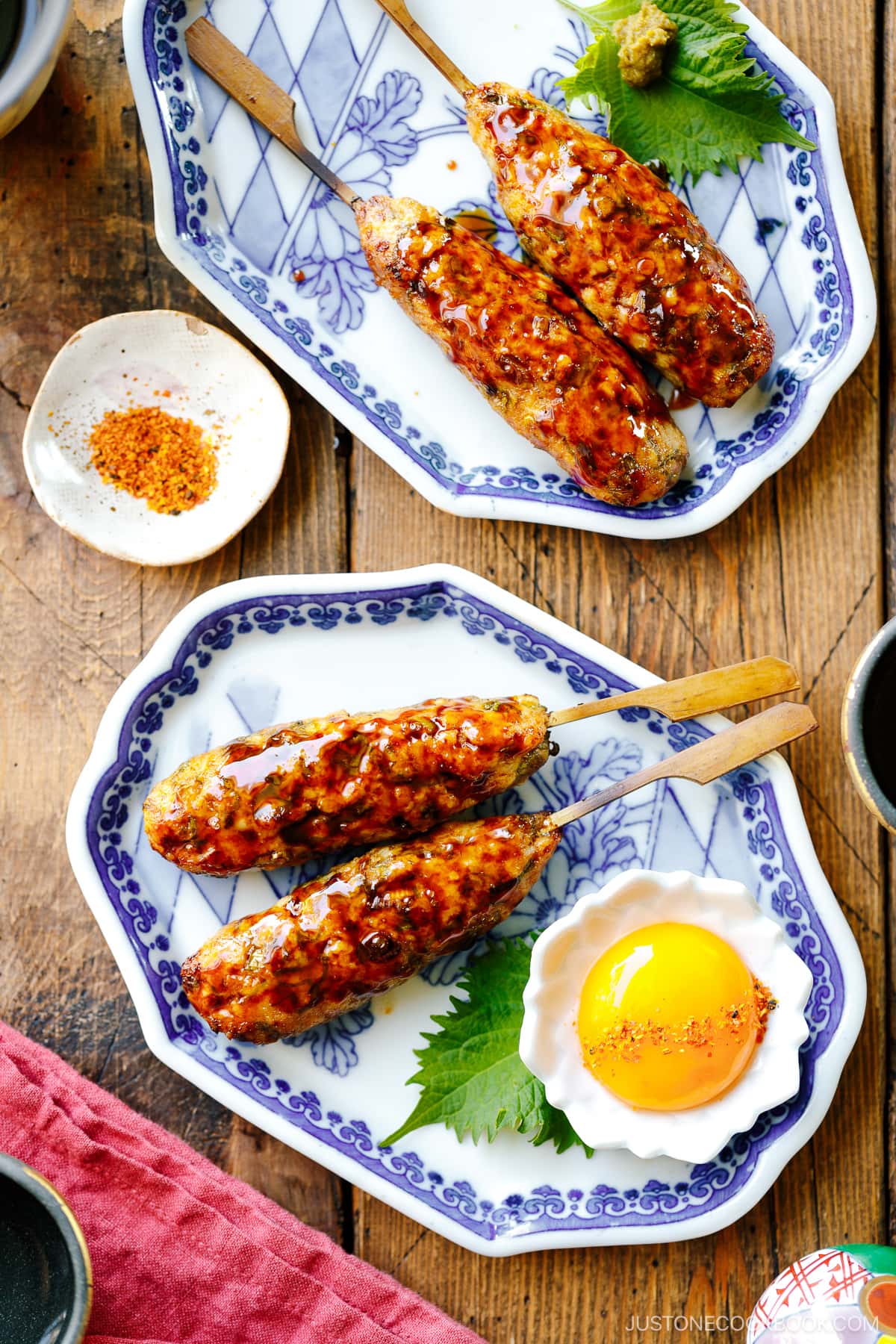
If you’re on the hunt for some crowd-pleaser recipes for your next party, look no further than the world of Japanese bar fare known as izakaya food! The dishes are often bite-sized or skewered and meant to be enjoyed in a lively, social setting. Picture the classics like Chicken Karaage, Yakitori, and Gyoza. The best part: They go hand in hand with sake and Japanese draft beer. Today, I’ve got another favorite that you need to try at home: Tsukune or Japanese chicken meatball skewers.
Table of Contents
What is Tsukune?
Tsukune (つくね) refers to Japanese chicken meatballs that are skewered, grilled, and coated with a sweet and savory sauce called tare.
To make tsukune, you’ll need ground chicken or a mix of chicken and pork, scallions, and various seasonings. The meat mixture is formed into an oval patty or three meatballs, which are then threaded onto bamboo skewers. They can be cooked either over charcoal at restaurants or pan-fried when prepared at home.
For family dinners, Japanese home cooks typically serve the meatballs without the skewers, so you can certainly make them in regular ball shapes. But if you’re serving tsukune for a party or a potluck, I recommend skewering them as demonstrated here. Everybody loves food on a stick!
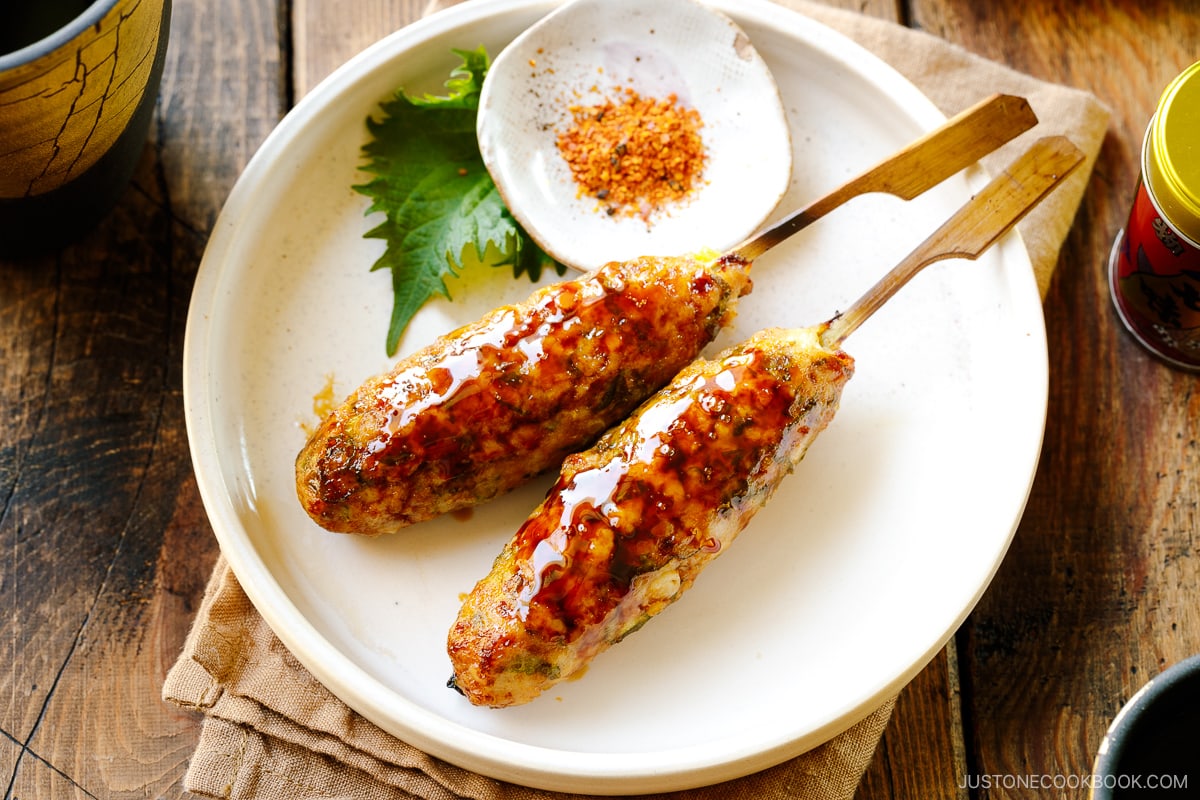
Tsukune Making Tips
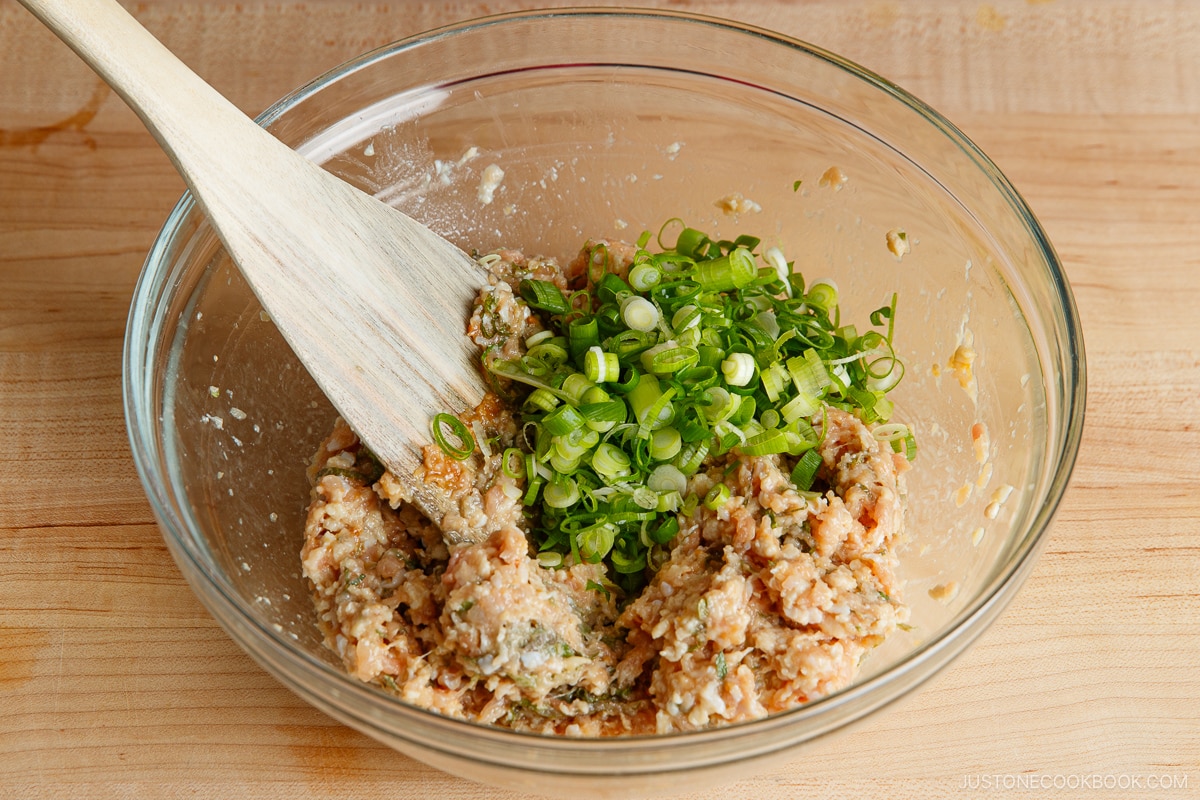
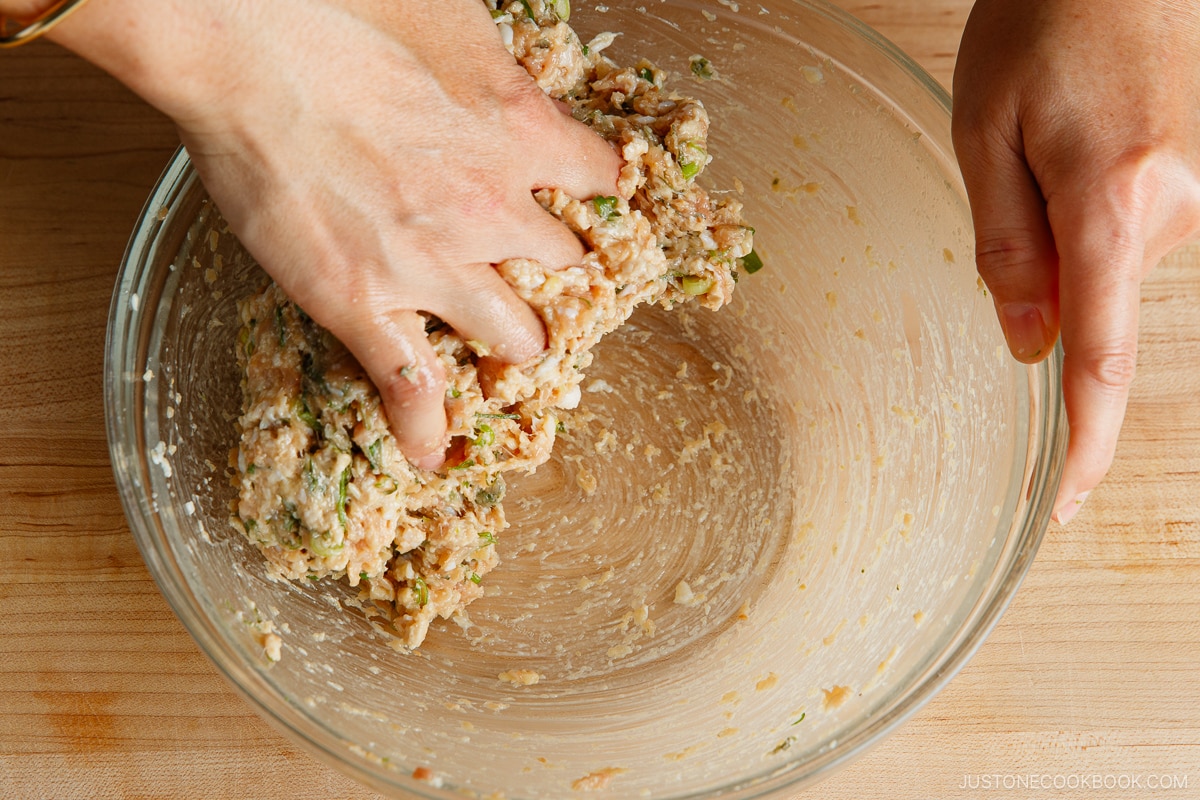
- Add texture and fragrance to the meat mixture. In Japan, we usually add chopped chicken cartilage to the mixture to create a contrasting texture. I also use shiso leaves and green onions for extra depth of aroma.
- Knead the chicken mixture until it becomes pale and sticky. Some tsukune recipes require eggs or panko to bind the ground meat together so that the meat mixture doesn’t easily fall off the skewers. However, my mom taught me to knead the mixture really, really well, and my tsukune never falls off the skewers!
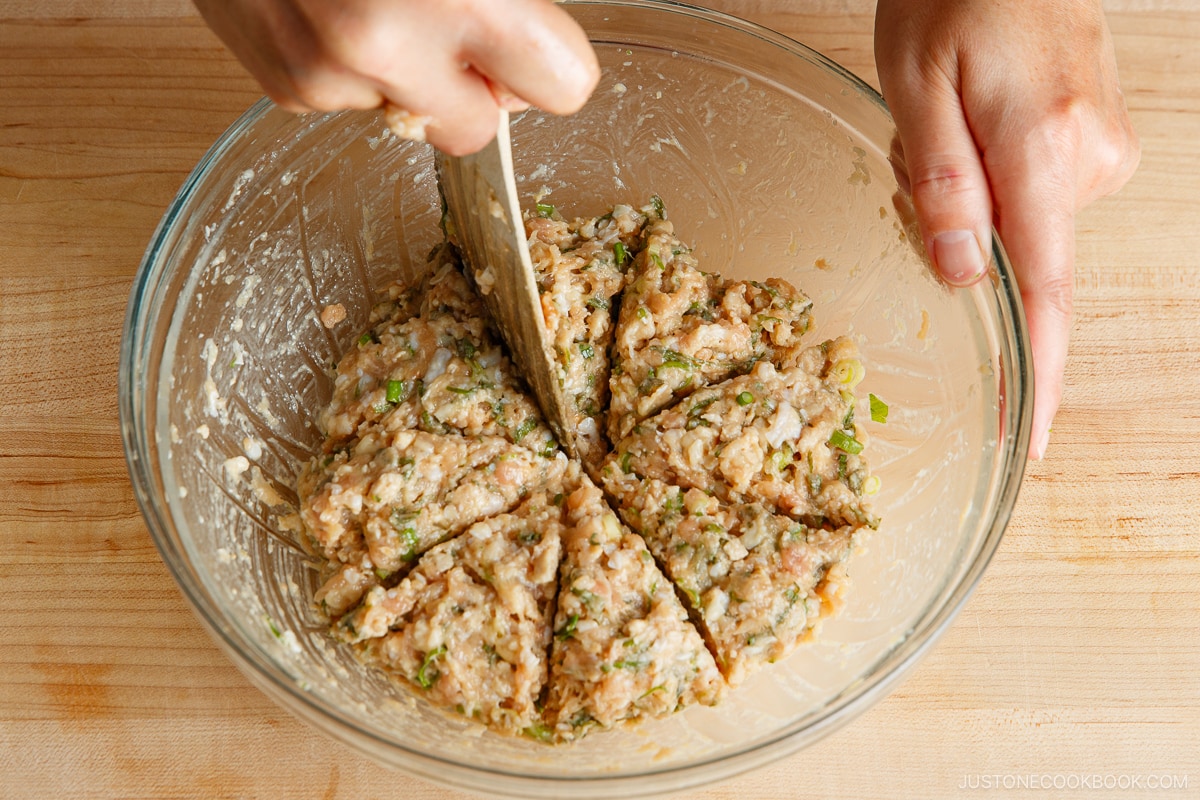
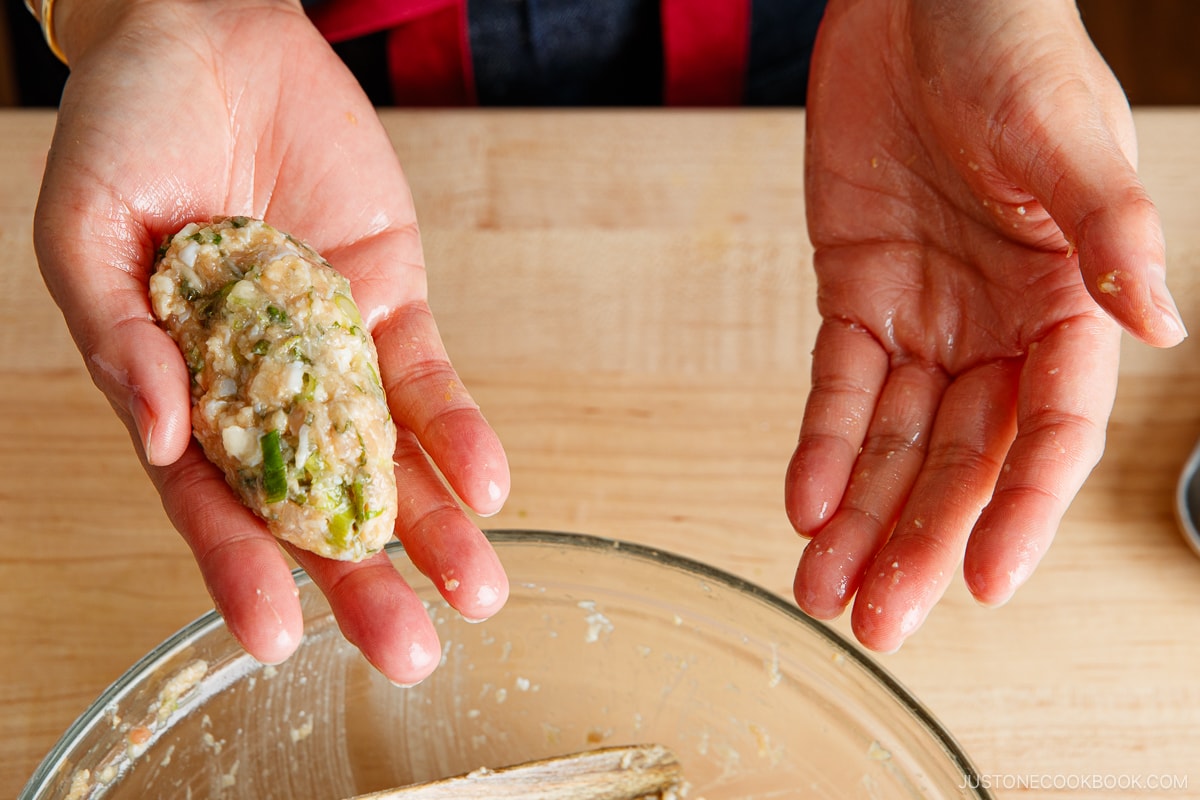
- Divide the meat mixture equally so each patty is roughly the same weight.
- Toss the meat from one hand to the other to release any air pockets. This prevents breakage.
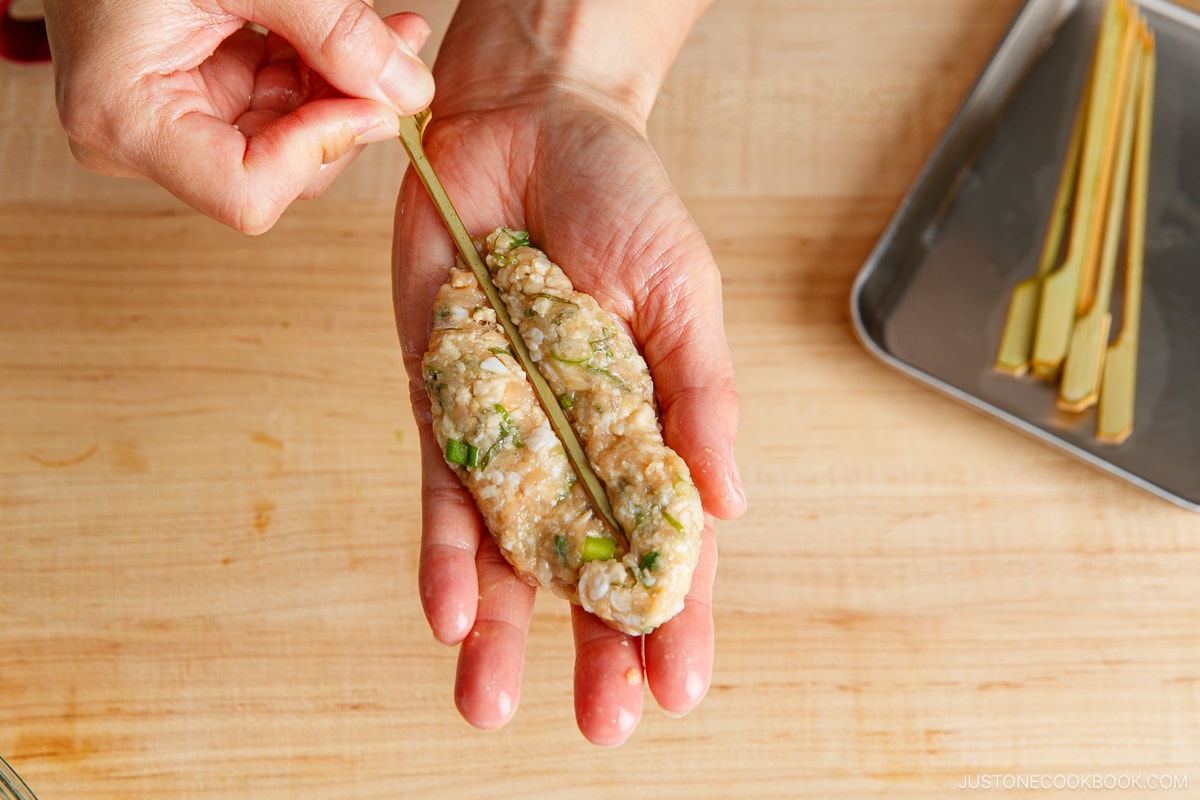
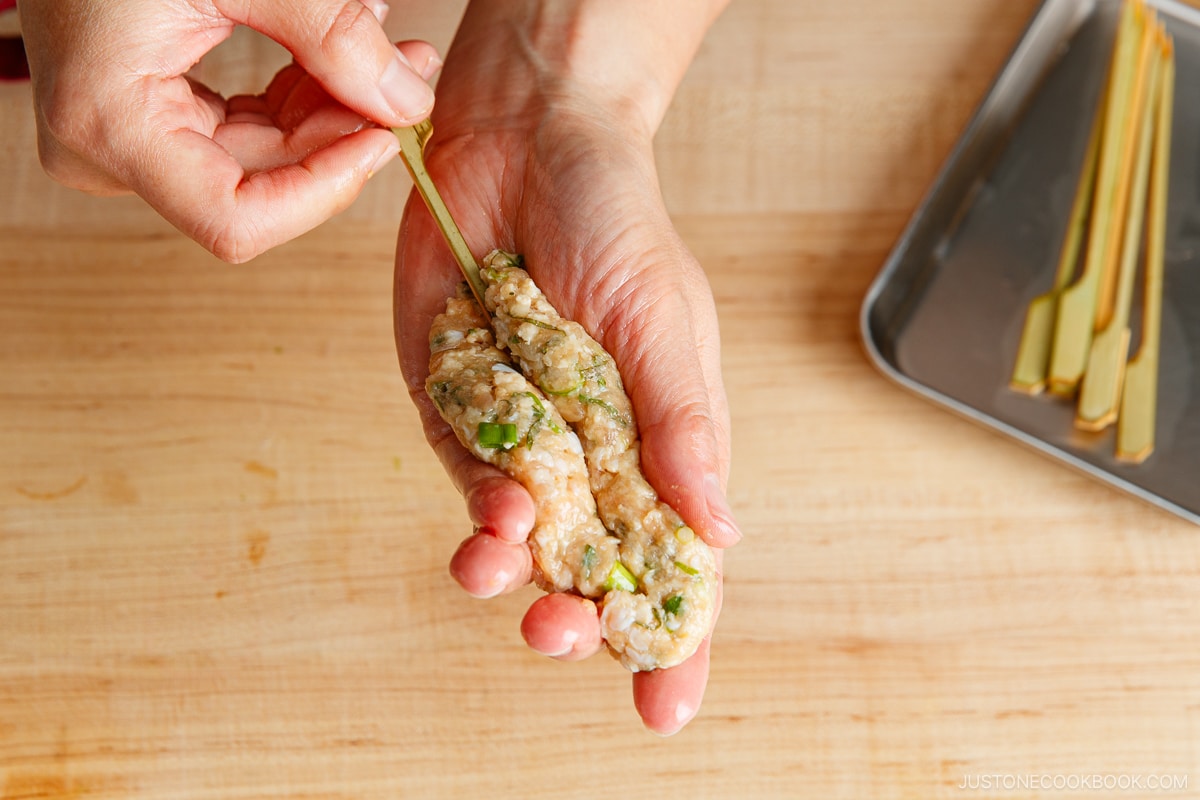
- Make a 4-inch long oval patty, then place a bamboo skewer on top. All the patties should be the same size so your tsukune is shaped the same.
- Press the skewer down a little and wrap the meat around the skewer. Form the meat into a nice 4-inch long cylindrical shape. Ensure the skewer is secured in place and the edges of the patty are sealed completely.
A Big Secret for Juicy Chicken Meatballs
When you make chicken meatballs, you want to make sure they are fluffy, springy, and juicy. I learned this technique from The Japanese Grill, one of my husband’s favorite grill cookbooks, and I’ve been following this method ever since.
To make the ground chicken mixture, precook one-third of the ground chicken first. Let it cool completely and then mix it with the raw ground chicken.
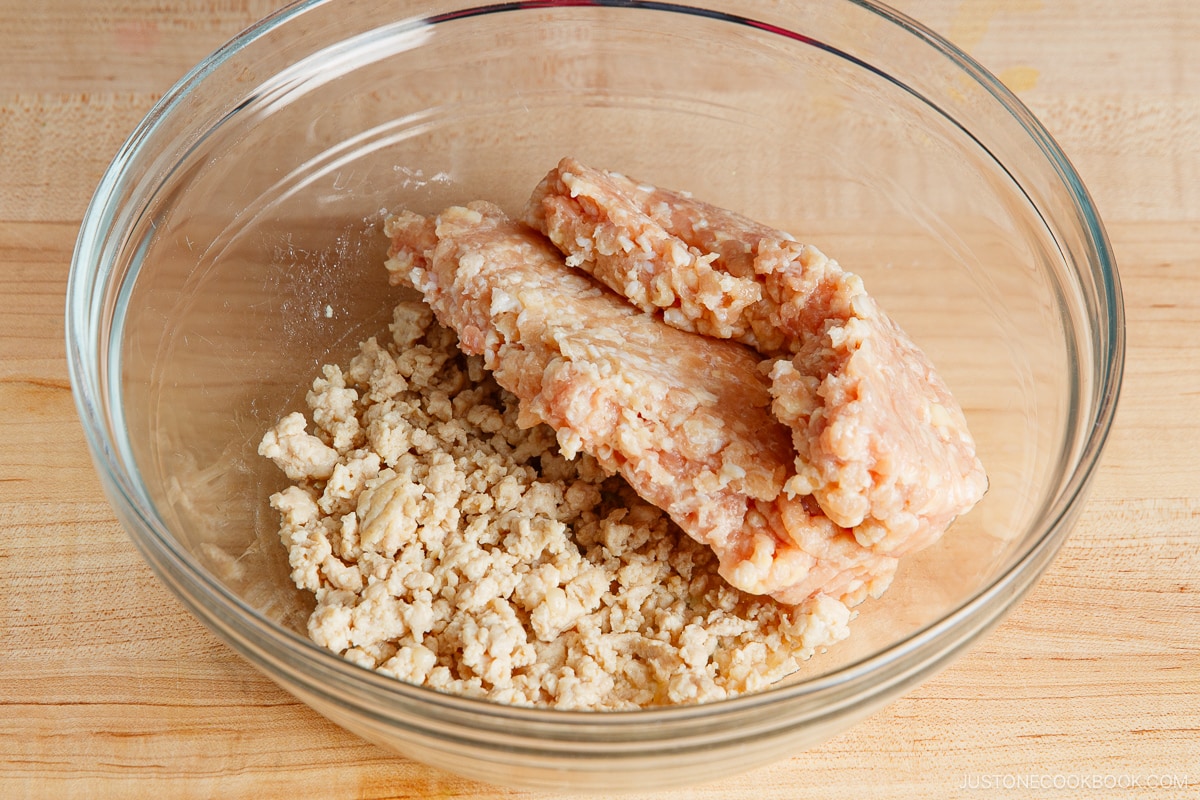
Do you notice when you cook the meat, you end up with much smaller pieces because the meat shrank after cooking? This technique of precooking a part of the meat mixture prevents the meat from shrinking too much.
Also, it prevents the meat from losing a lot of juice. Although it is an extra step, I find it’s totally worth it.
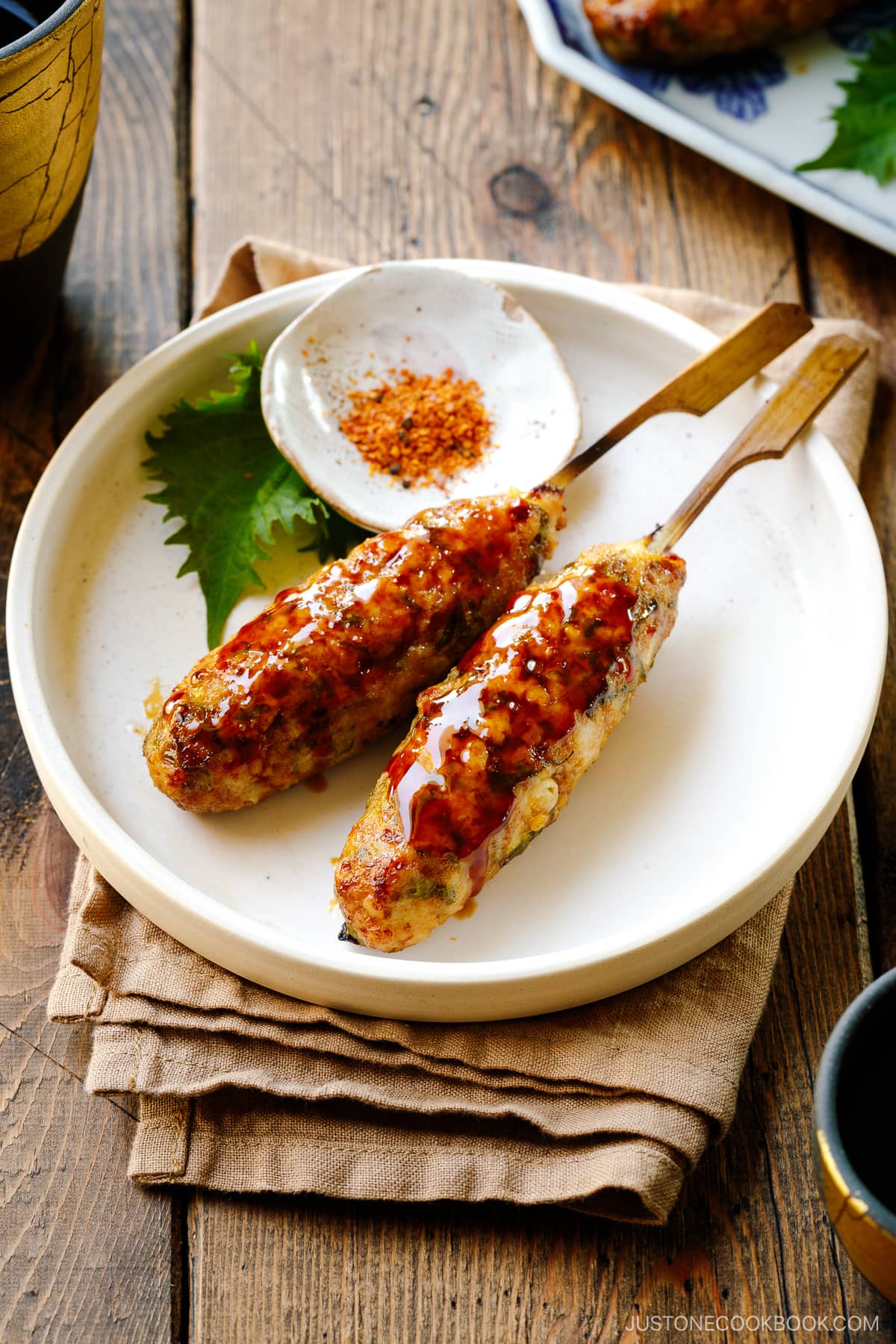
How to Use the Broiler When Cooking the Tsukune
To make the tsukune similar to the restaurant style, use the broiler in the oven. Unlike baking, which uses hot air to cook the food, the broiler uses infrared energy similar to an outdoor grill. When it’s done cooking, the tsukune comes out really juicy and beautifully charred.
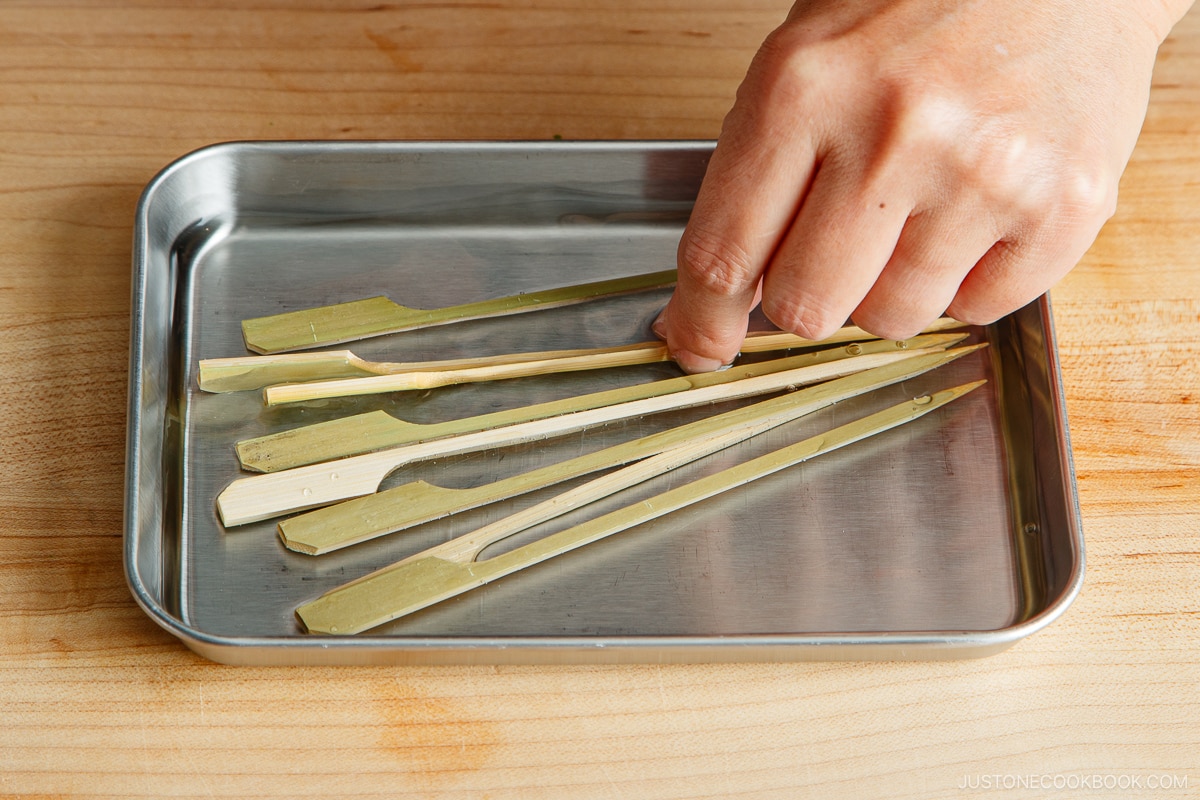
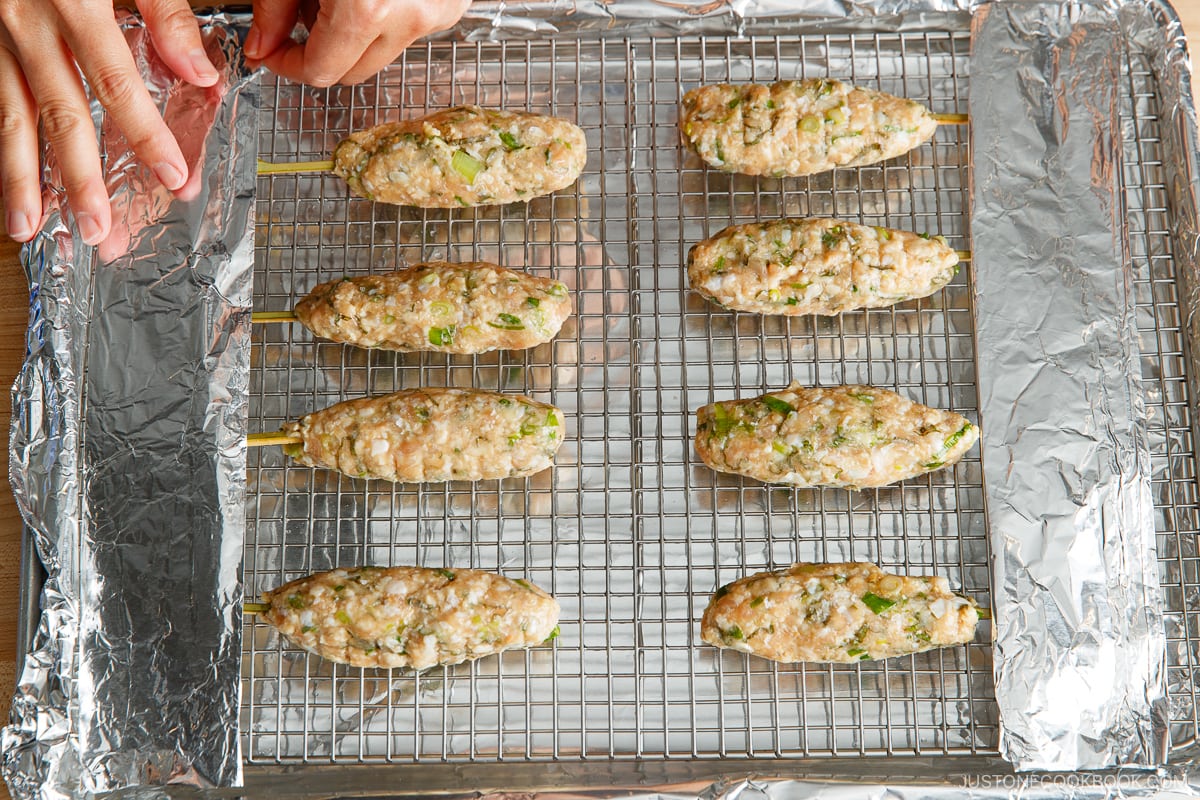
Here are some important tips for you.
- Create patties that are evenly sized and not too large. Shape each patty into a thin, long cylindrical form to allow for quick heat penetration. This ensures that they all cook at the same rate and finish simultaneously.
- Use an oven-safe wire rack to allow the meat’s excess oil to drip onto the baking sheet, preventing the meat from cooking in the accumulated oil.
- Before broiling, soak the bamboo skewers in water and cover them with foil. This step prevents the skewers from burning and turning black.
- Control the oven rack’s distance from the top heating element and the broiling time. I set my oven rack in the center position, 9 inches (23 cm) away from the top heating element. With the broiler, you cannot set an exact temperature. However, you can adjust two things: the distance of the rack and the broiler settings (Low, Medium, High). I usually use the High setting (550ºF/288ºC) and adjust the rack’s proximity to the heating element.
- Keep a close eye on the food while broiling. If you’re new to using the broiler, exercise caution to avoid overcooking until you determine the optimal rack position and broiler setting.
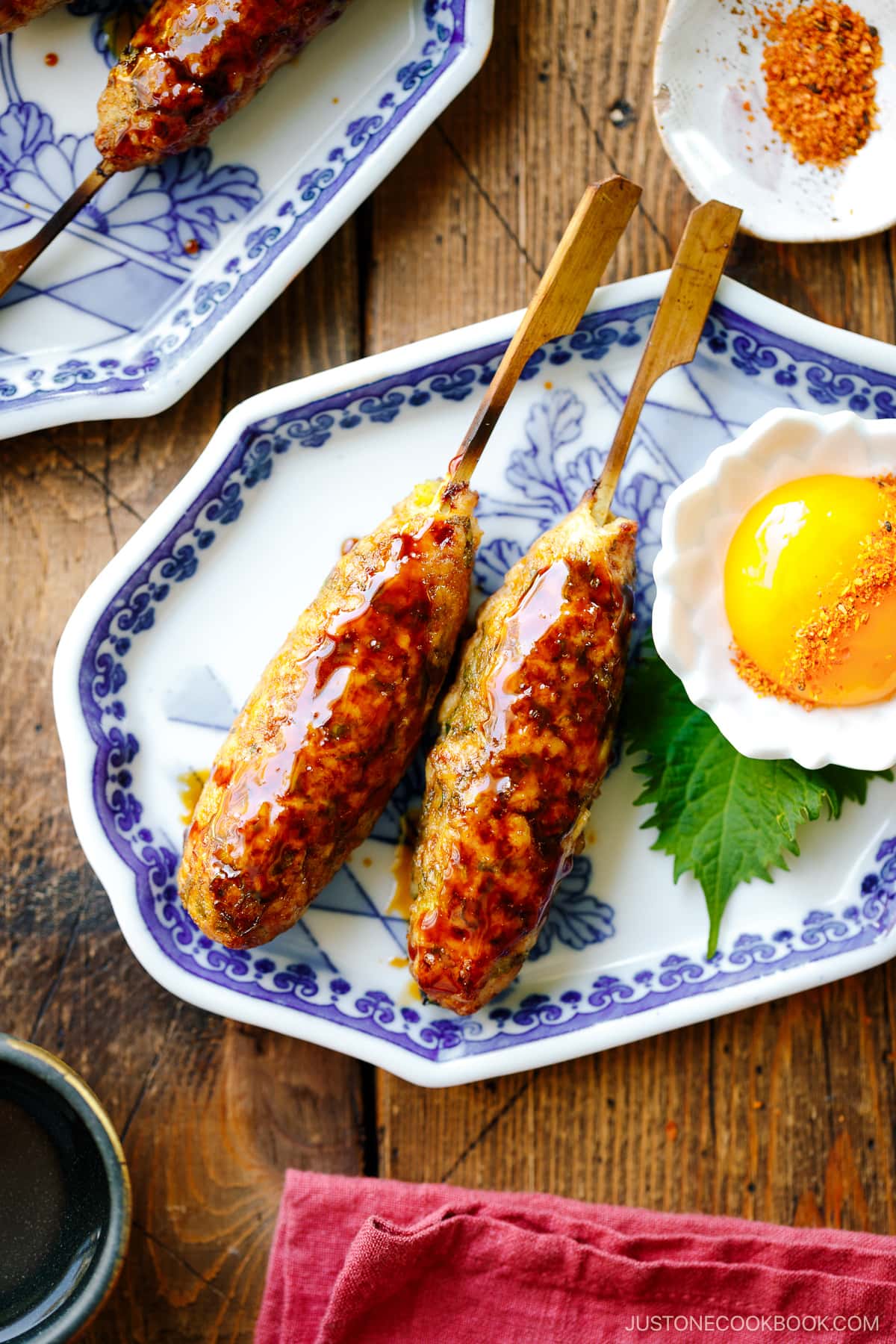
How to Make Tsukune
The Ingredients You’ll Need
- Ground chicken
- Shiso leaves – Skip if you can’t find them. It definitely tastes better with it.
- Scallions
- Seasonings: Miso, sesame oil, and salt
- Homemade yakitori sauce: sake, mirin, soy sauce, and brown sugar
- For serving (optional): Shichimi togarashi and raw egg yolk (please see the note below)
The Cooking Steps
- Cook one-third of ground chicken on medium-low heat in an ungreased frying pan. Set aside and let cool completely.
- Combine cooked and raw ground chicken, shiso, scallions, and seasonings. Knead the mixture until it becomes sticky and pale in color.
- Line a baking sheet with aluminum foil and place an oven-safe wire rack on top. Shape the ground chicken mixture into an oval patty and wrap it around a skewer. Place the finished skewer on the baking sheet and continue with the rest of the mixture.
- Cook the skewers under the broiler for 6 minutes, and flip to cook for 3-4 minutes. Next, brush the yakitori sauce on the chicken and broil for 45–60 seconds until bubbling. Then, flip the chicken, brush the other side, and broil for another 45–60 seconds until bubbling.
- Serve immediately and enjoy! Sprinkle with shichimi togarashi for a spicy kick. Optionally, dip in a raw egg yolk to enjoy.
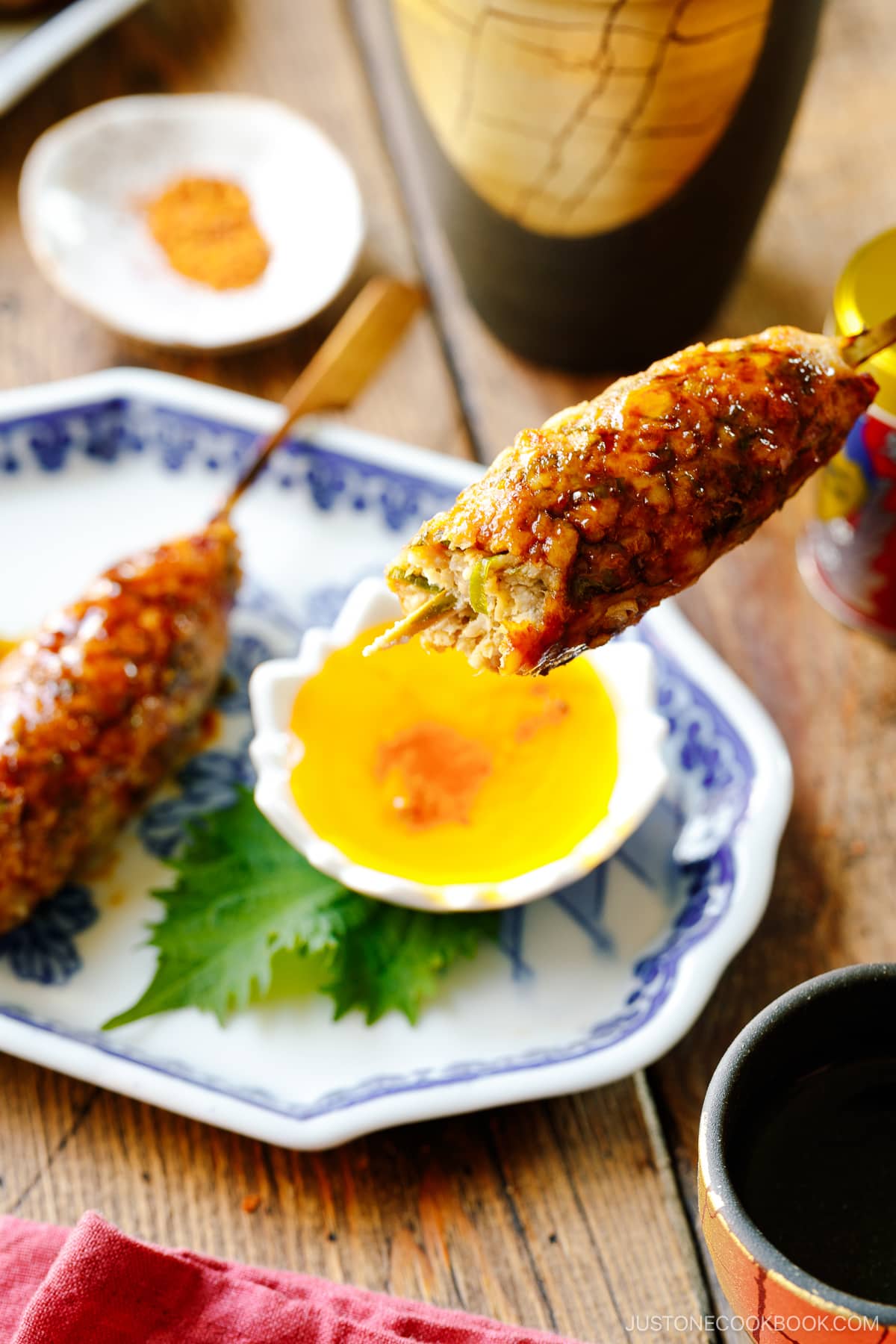
Homemade Yakitori Sauce
Elevate your tsukune with this homemade sauce—it’s the secret to taking them from good to absolutely mouthwatering! All you have to do is mix together five simple ingredients: sake, mirin, soy sauce, brown sugar, and water. Then, let it simmer away on medium-low heat for about 30 minutes until it reduces by half and thickens up. Trust me, it’s a breeze!
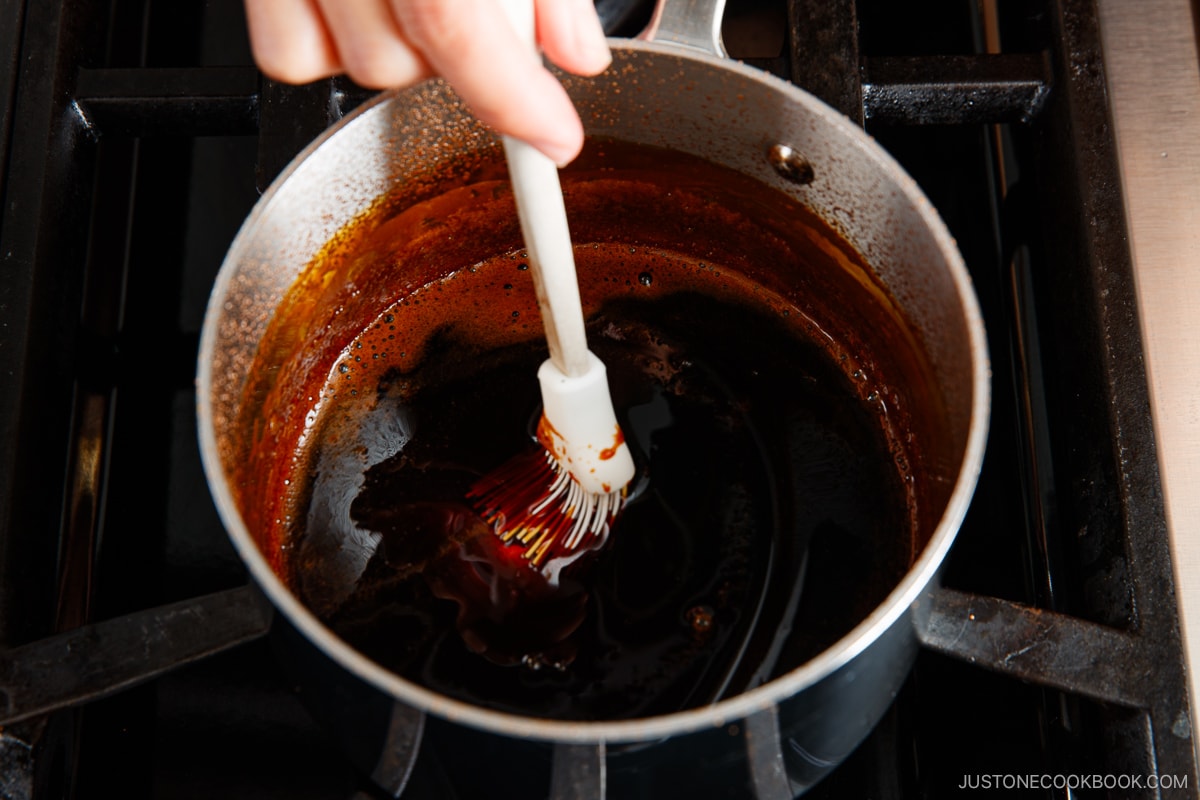
My yakitori sauce recipe below will yield some extra, so save the leftover for other dishes. You can dilute it with a little bit of water to thin it and use it as a marinade or stir-fry sauce.
How to Eat Tsukune
Tsukune is delicious when brushed with yakitori sauce alone, but there are other fun ways to enjoy the meatball skewers too!
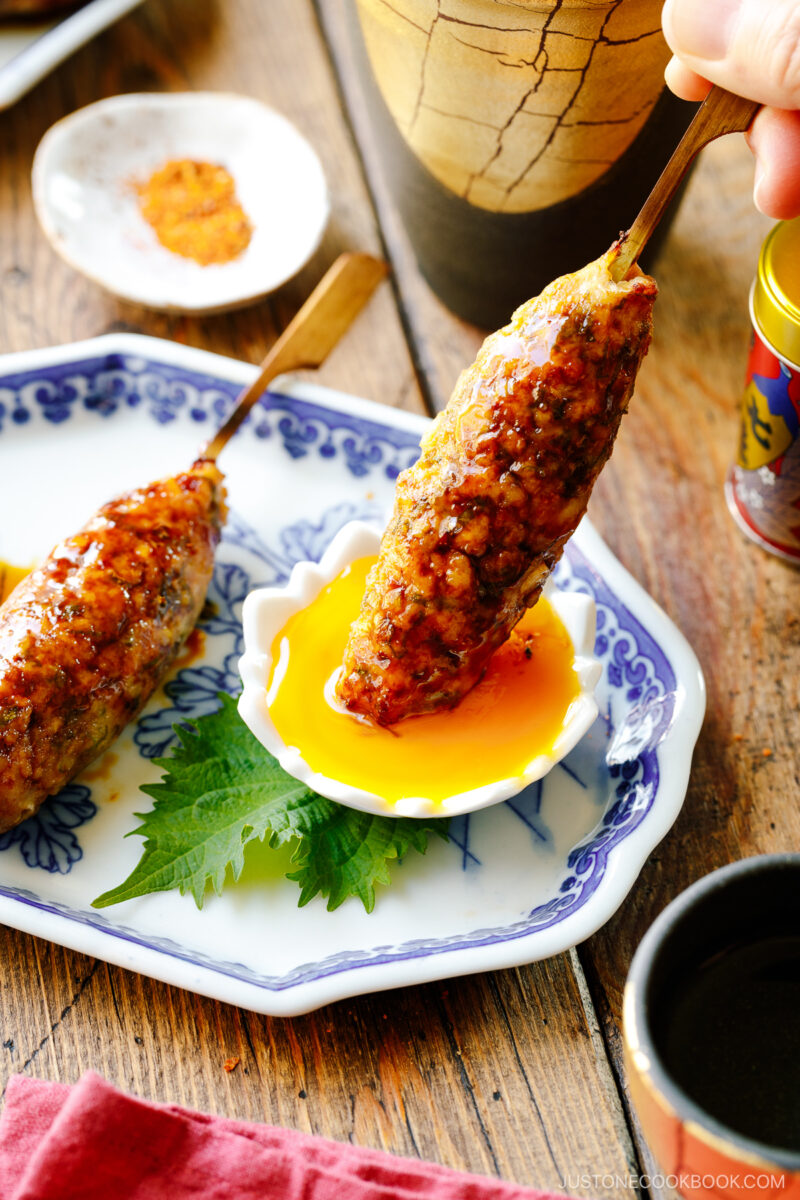
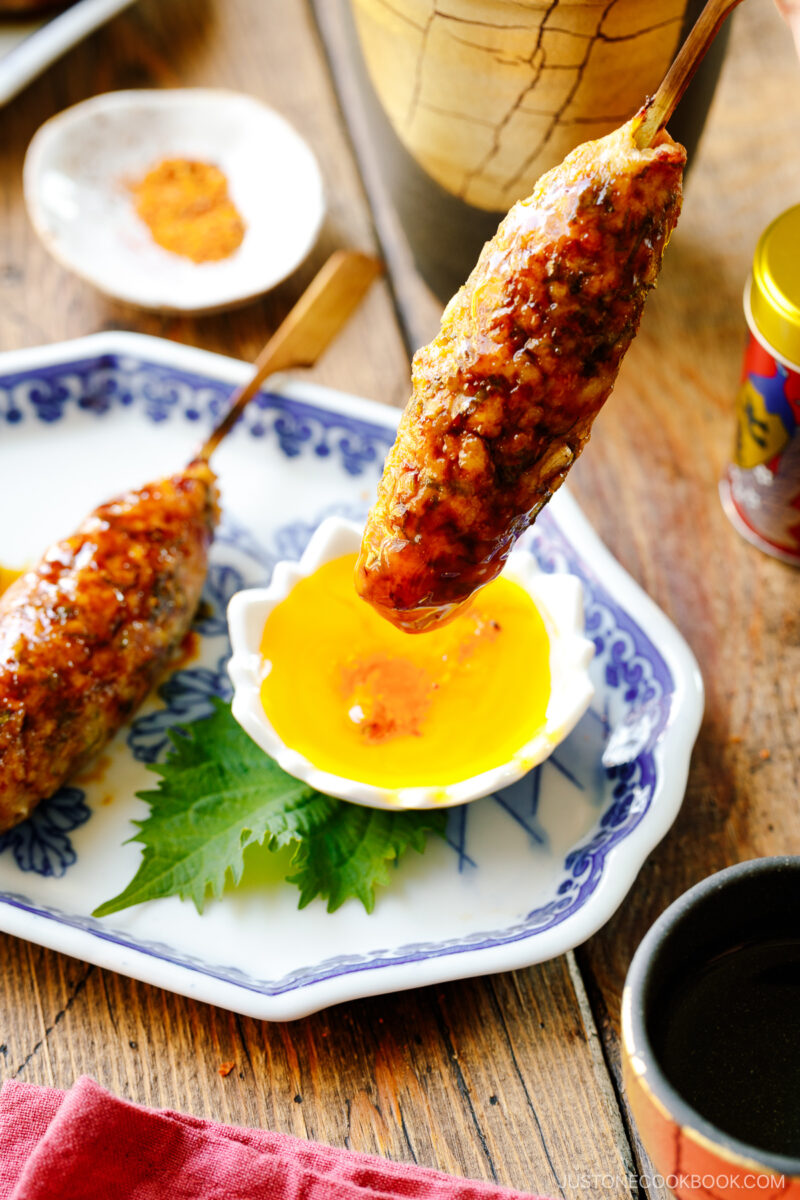
- Dip in raw egg yolk. Eating raw eggs is common in Japan. Eggs are processed differently there and raw eggs are considered safe to consume. Dipping the sweet and salty chicken meatball in rich, creamy, and naturally sweet egg yolk makes it extra delicious.
- Dip in Japanese mayonnaise. I highly recommend Japanese mayo here like the Kewpie brand. Then, sprinkle with a bit of shichimi for a spicy kick.
- Sprinkle with shichimi togarashi. Need a spicy kick? Sprinkle shichimi over the tsukune.
- Enjoy it with yuzu kosho. The citrusy hot sauce gives a bold and spicy taste. Give it a try!
What to Serve with Tsukune
- Beverages: Sake, Japanese beer
- Appetizers: Agedashi Tofu, Spicy Edamame, Cold Tofu (Hiyayakko)
- Mains: Teba Shio (Salted Chicken Wings), Kakuni (Braised Pork Belly)
- Salads: Japanese Potato Salad, Tofu Salad with Sesame Ponzu Dressing
- Rice: Onigiri (Japanese Rice Balls), Yaki Onigiri (Grilled Rice Balls)
Also, don’t forget to try out my Teriyaki Chicken Meatballs and Meatballs with Sweet and Sour Sauce.
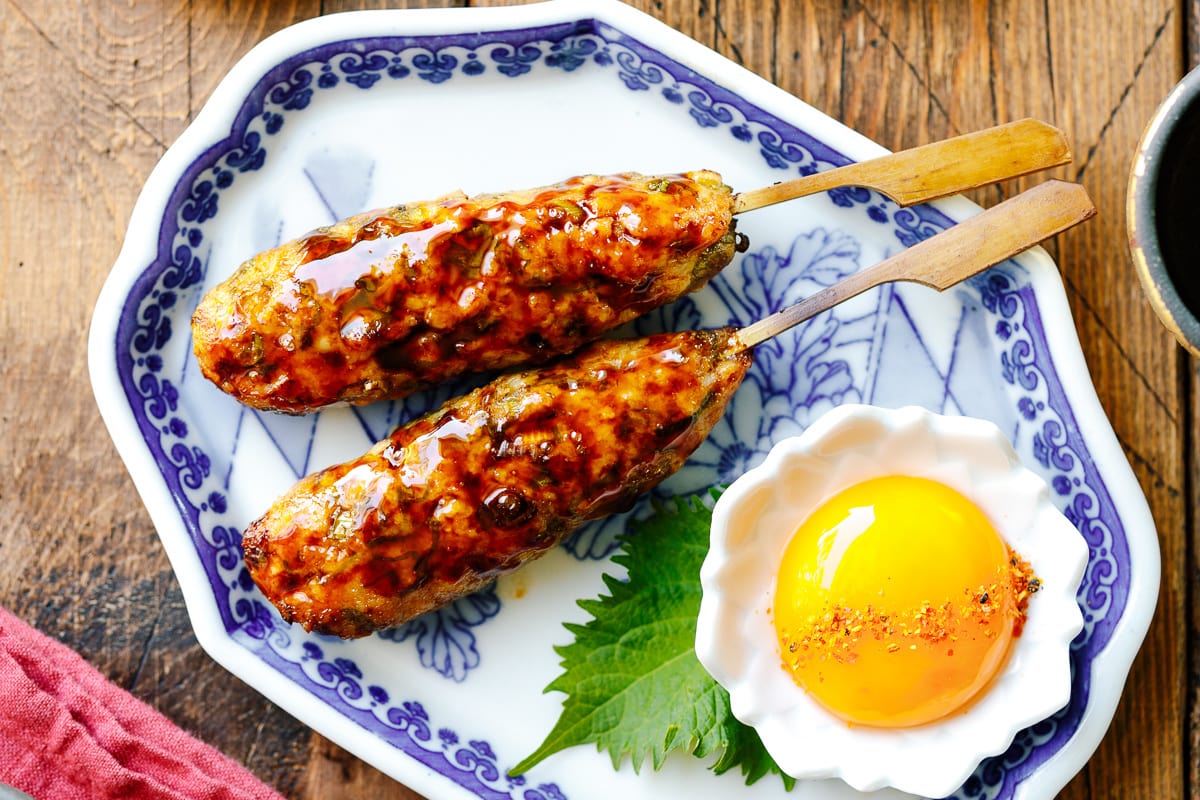
Wish to learn more about Japanese cooking? Sign up for our free newsletter to receive cooking tips & recipe updates! And stay in touch with me on Facebook, Pinterest, YouTube, and Instagram.

Tsukune (Japanese Chicken Meatball Skewers)
Video
Ingredients
For the Yakitori Sauce (enough for 2 batches of tsukune)
For the Tsukune
- 2–3 green onions/scallions
- 6 shiso leaves (perilla/ooba)
- 1 lb ground chicken (use half white meat + half dark meat if grinding your own)
- 1 Tbsp toasted sesame oil (plus more for coating your hands)
- 1 Tbsp miso (any type of miso works)
- coarse sea salt (for sprinkling)
For Serving
- shichimi togarashi (Japanese seven spice) (optional, for a spicy kick)
Instructions
- Gather all the ingredients.
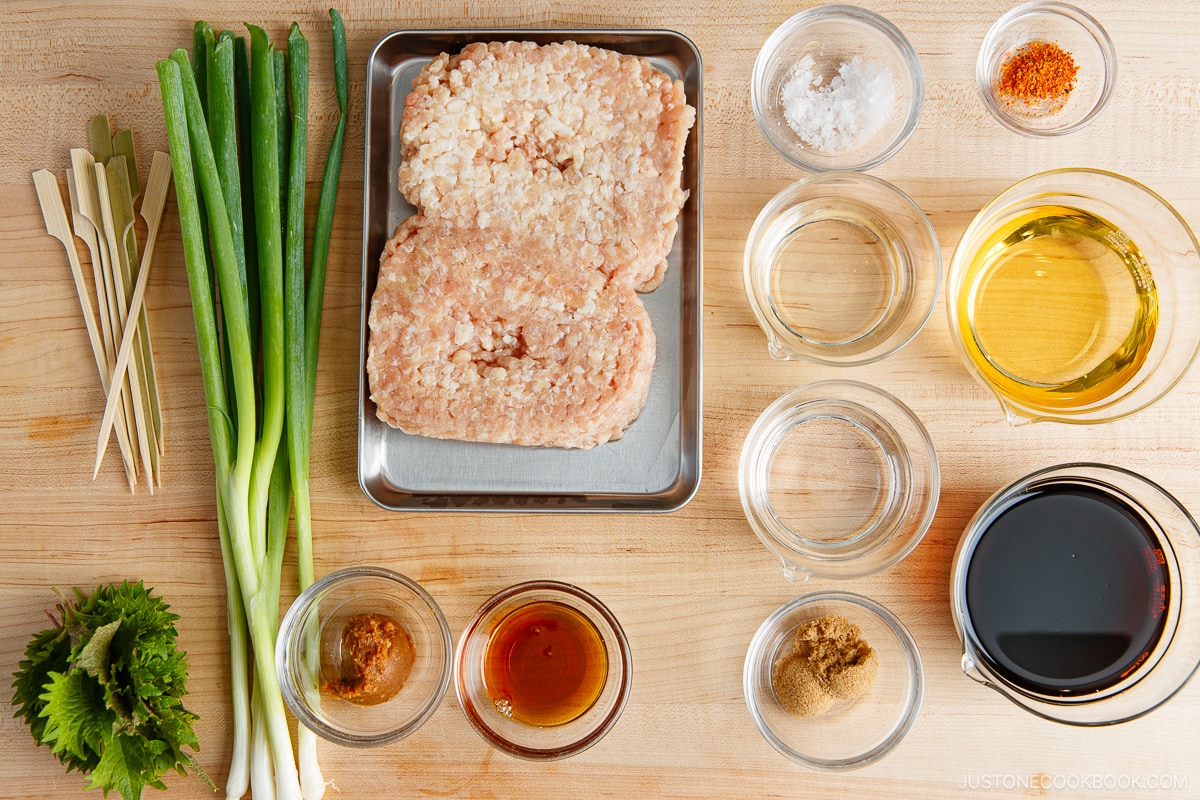
- Soak 8 bamboo wooden paddle skewers (6 inches long) in water for 30 minutes. Soaking will prevent the sticks from burning while broiling.
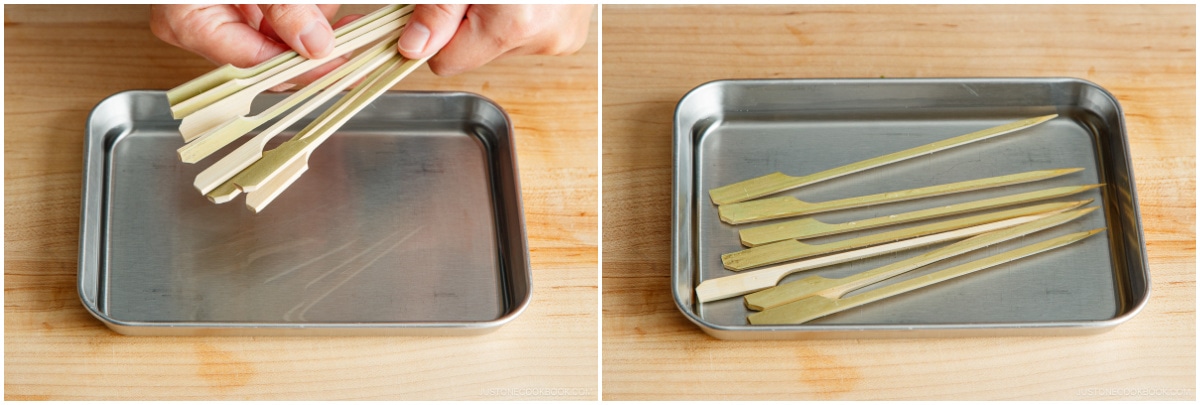
To Make the Yakitori Sauce
- In a small saucepan, combine ¼ cup water, ¼ cup sake, ½ cup mirin, ½ cup soy sauce, and 2 tsp brown sugar.
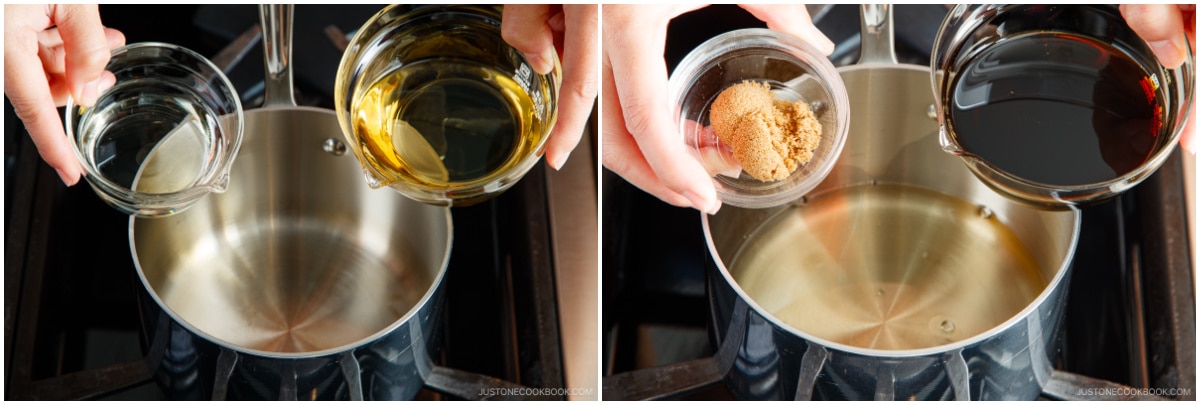
- Bring the mixture to a boil over medium heat. Once boiling, lower the heat to a simmer and cook for about 30 minutes. Meanwhile, start preparing the tsukune mixture.
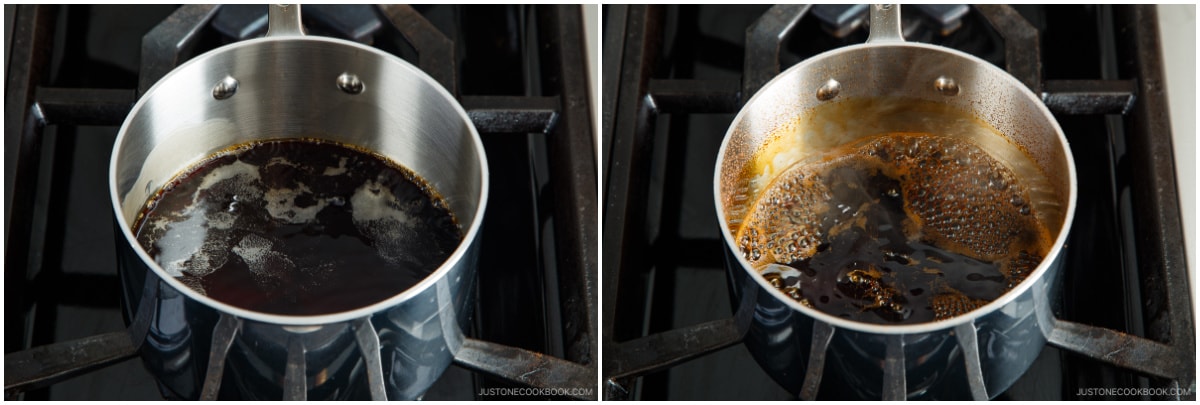
- When the sauce has thickened and reduced by half, remove from the heat. Remember, the sauce will continue to thicken as it cools and moisture evaporates.
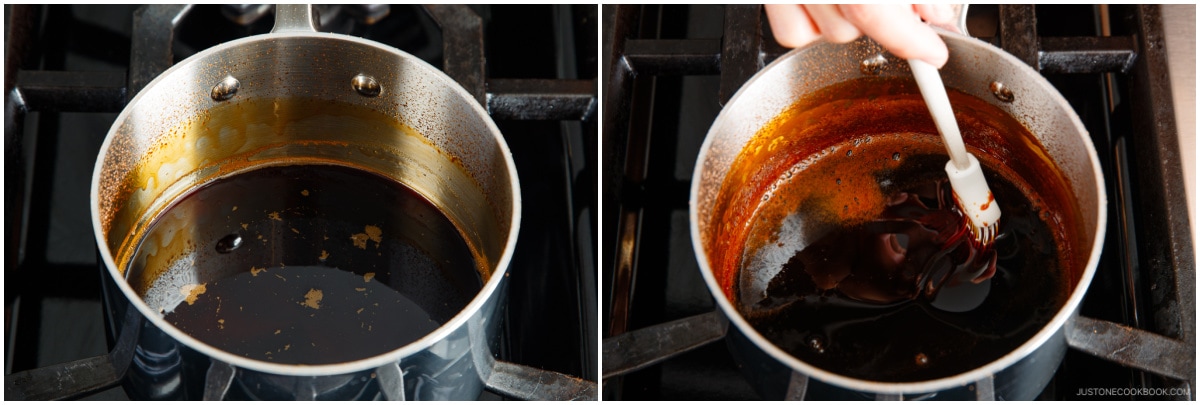
To Make the Tsukune Mixture
- Heat an ungreased frying pan over medium heat. When it’s hot, add one-third of the 1 lb ground chicken. If your ground chicken package includes both a fatty and lean part (like the kind sold at Nijiya Market near me), use the lean part here and keep the fatty part for later. Tip: Precooking some of the meat mixture prevents the meatball from shrinking too much while cooking and keeps the tsukune juicy.
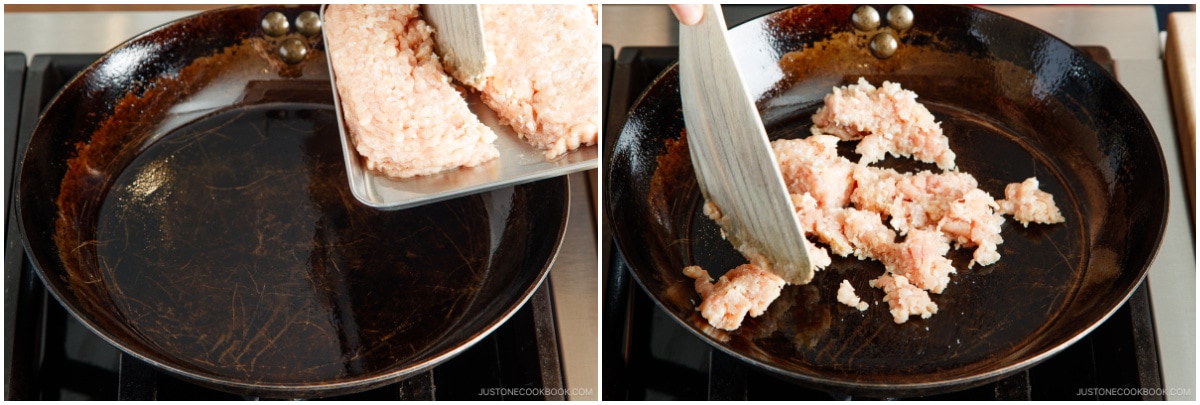
- Cook the meat—without browning it—until no longer pink. While cooking, break it up into small pieces with a wooden spatula.
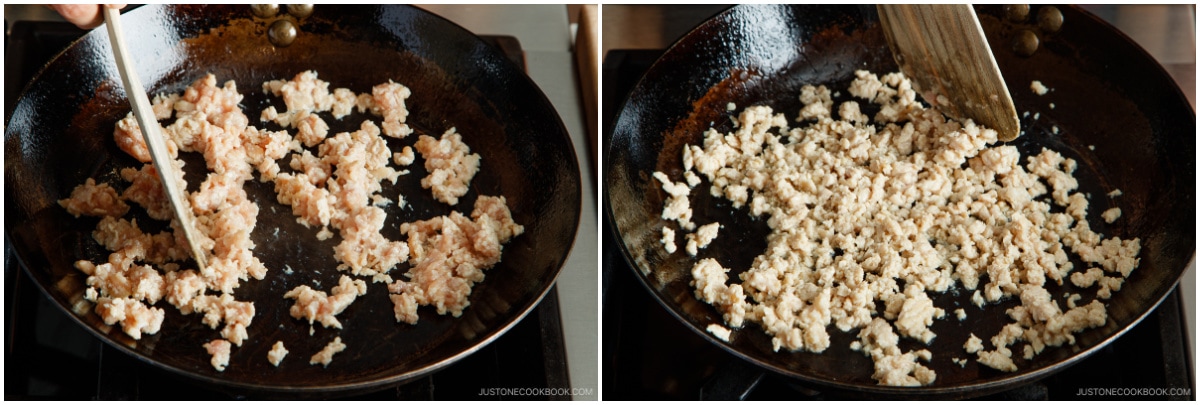
- Transfer the cooked meat to a large bowl and let it cool completely.
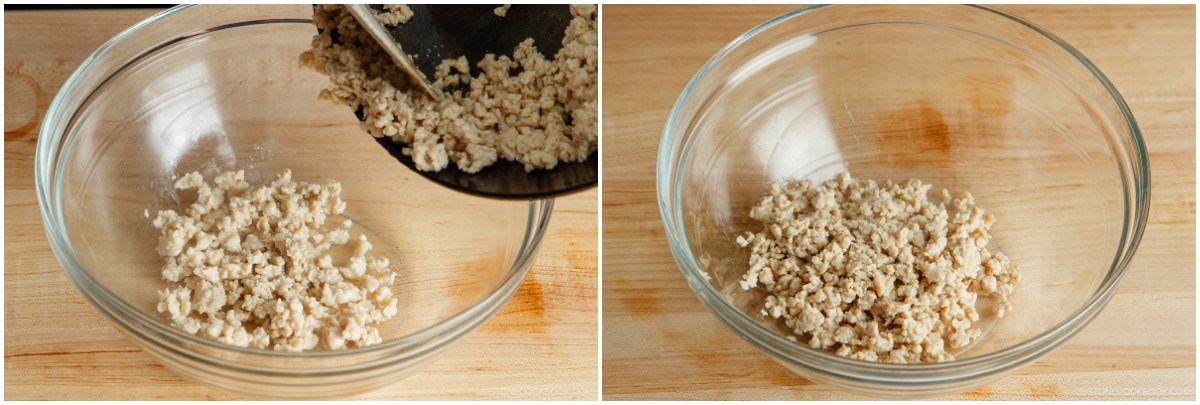
- Stack and roll up 6 shiso leaves (perilla/ooba), then cut into thin julienned slices.
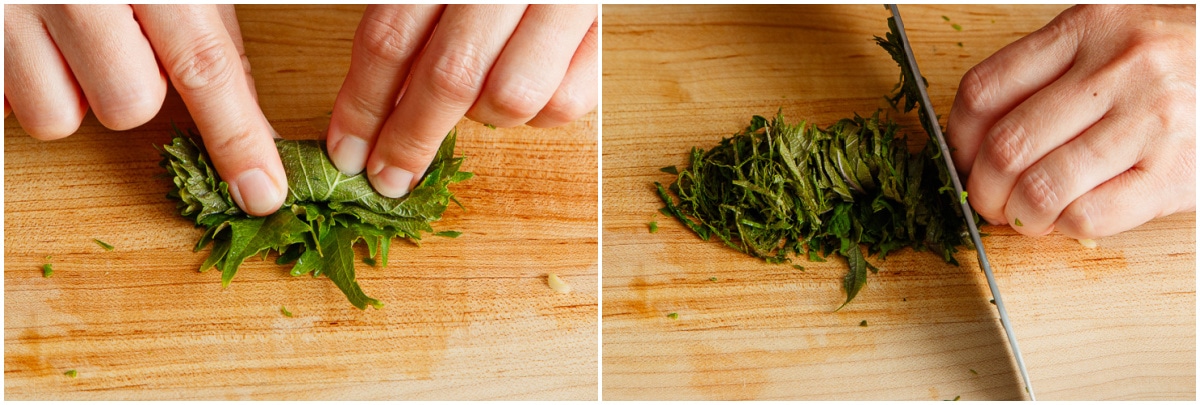
- Cut 2–3 green onions/scallions into thin slices.
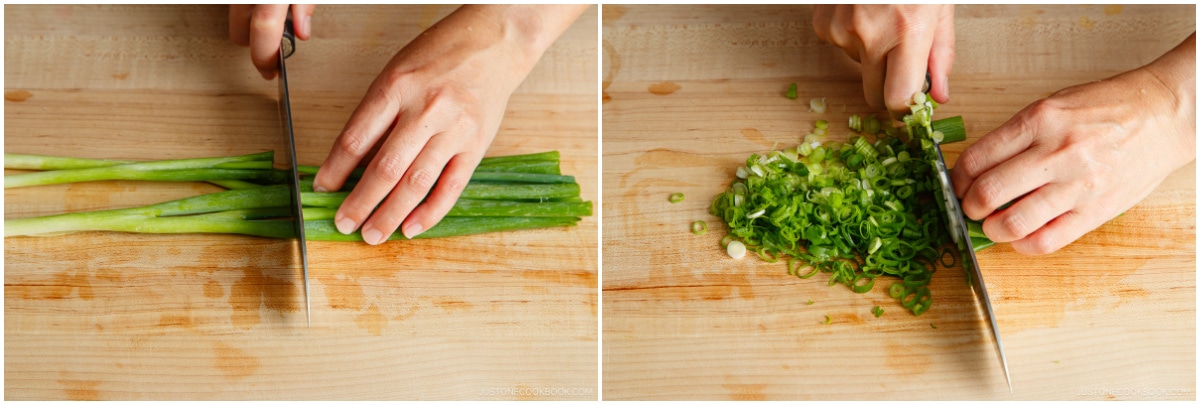
- When the cooked ground chicken is completely at room temperature, add the remaining uncooked ground chicken to it and combine. Then, add 1 Tbsp miso and 1 Tbsp toasted sesame oil.
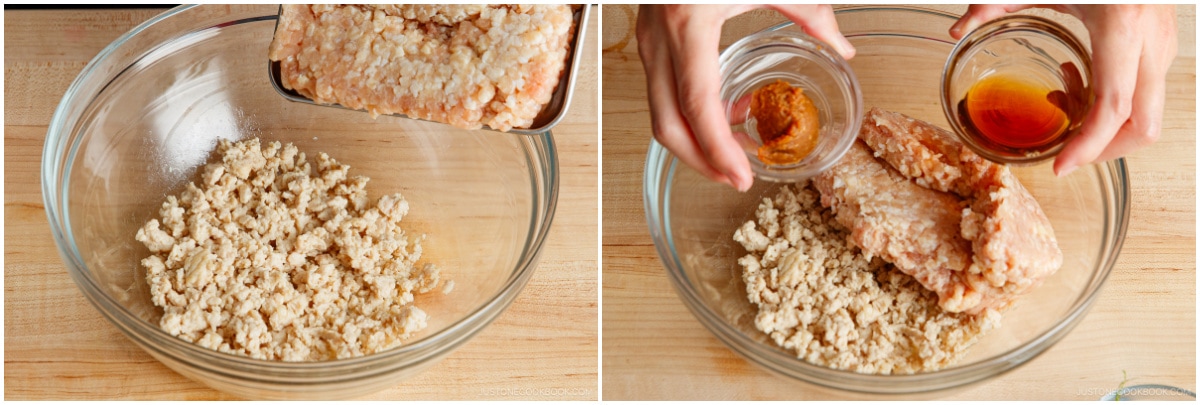
- Using the wooden spatula, knead the mixture well.
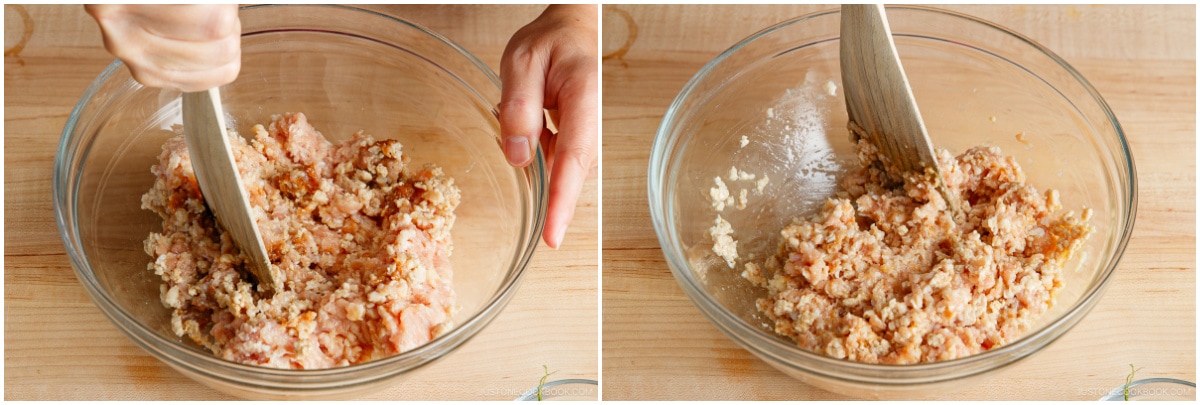
- Add the julienned shiso and knead well.
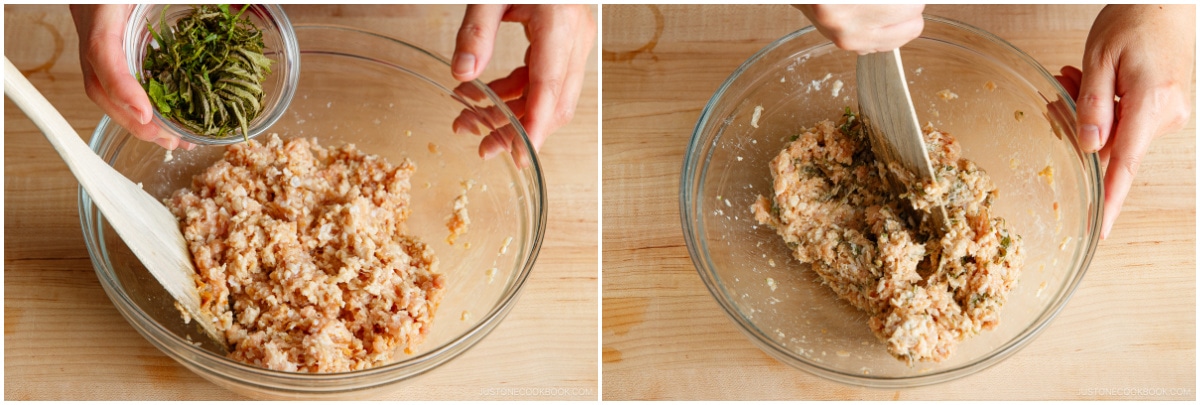
- Add the chopped green onions and knead well.
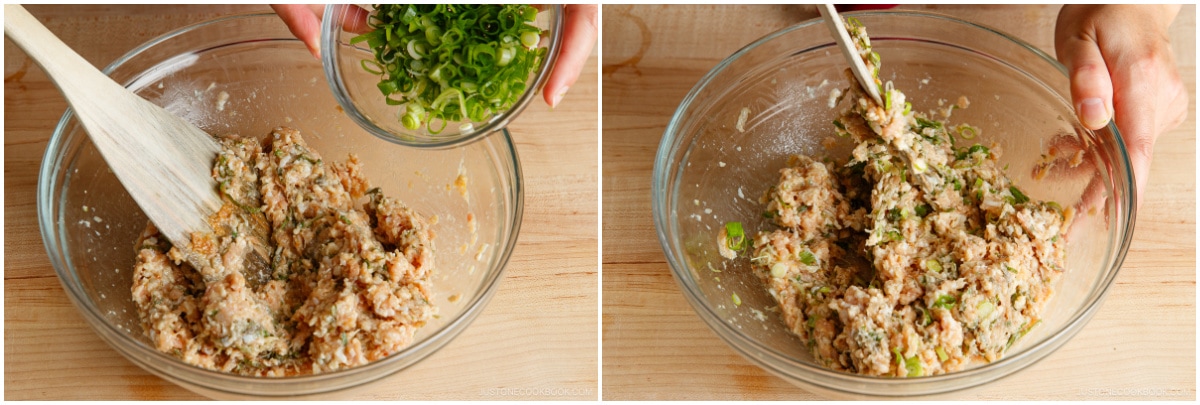
- With the wooden spatula, spread the mixture around the bowl and then mix. Repeat it a few times.
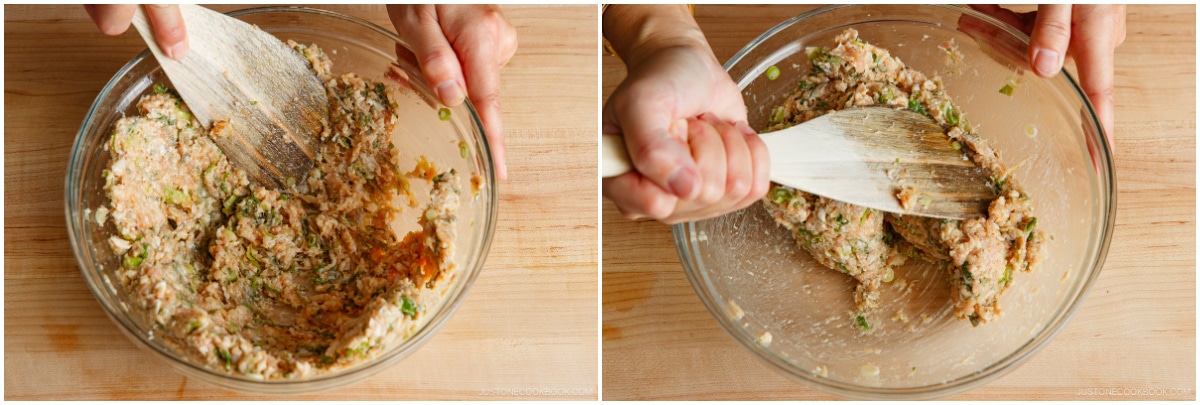
- Now, switch to mixing by hand. Knead and fold the mixture in a clockwise direction 30 times. Then, knead it counterclockwise 30 times. The meat will become paler in color and sticky. This process is very important for the meat to stay on a stick, so please do not skip this step. Tip: If the fat in the mixture starts to look melted, refrigerate it for 10 minutes, then continue kneading until the mixture is pale and sticky.
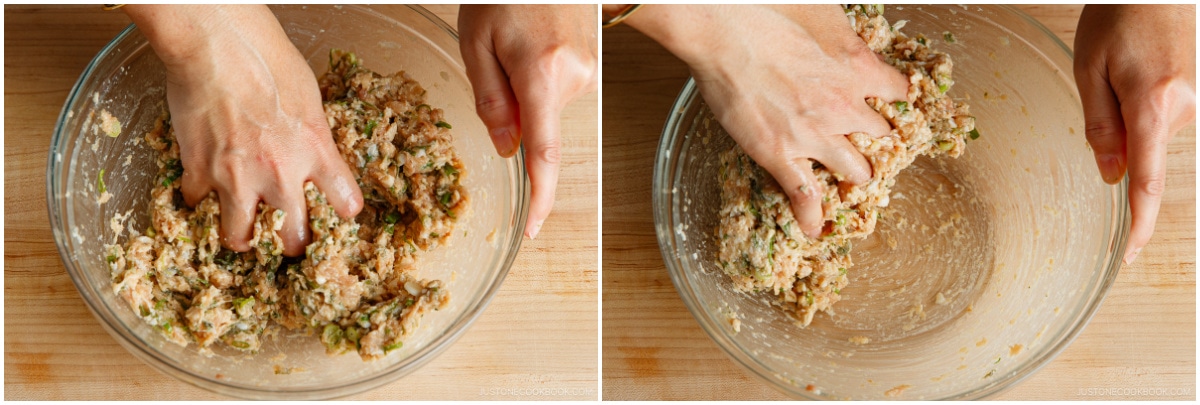
- Now, divide the mixture into 8 equal portions. Patties that are the same size will cook at the same rate and finish cooking at the same time.
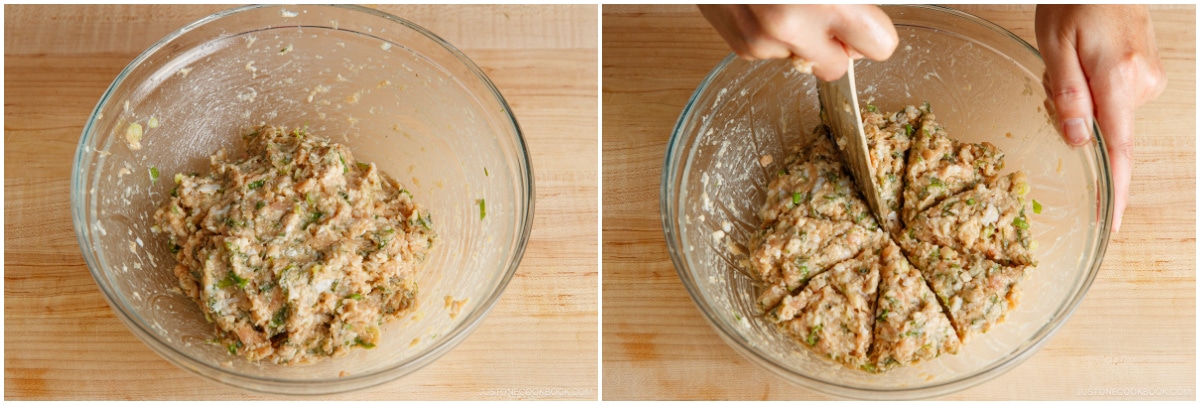
To Shape the Tsukune
- Prepare a baking sheet lined with aluminum foil. Place an oven-safe wire rack on top and brush it with cooking oil. Why use a rack? It allows the excess oil from the meat to drip down to the baking sheet while broiling. This way, the meat chars nicely and comes out juicy. To achieve a restaurant-style tsukune, we don‘t want to cook it in a pool of oil.
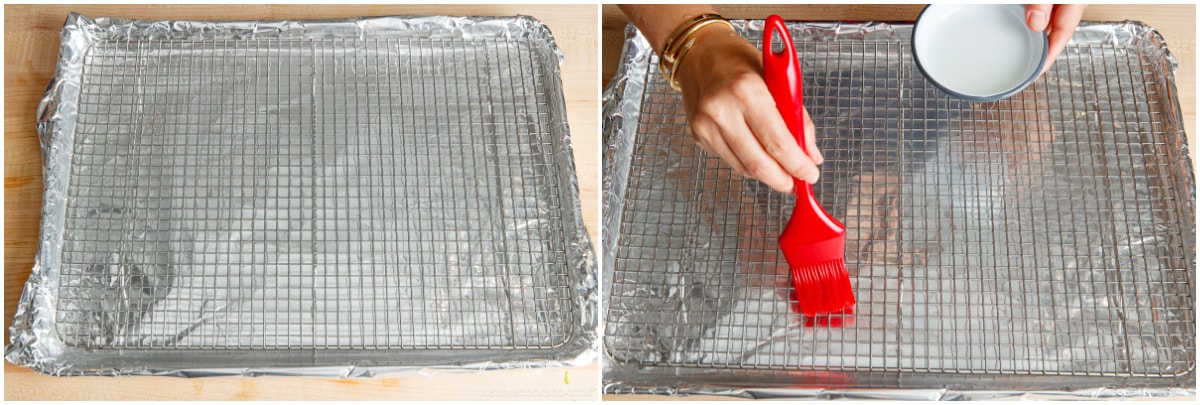
- Lightly coat your hands with sesame oil to prevent the meat from sticking. Scoop up one portion of the chicken mixture.
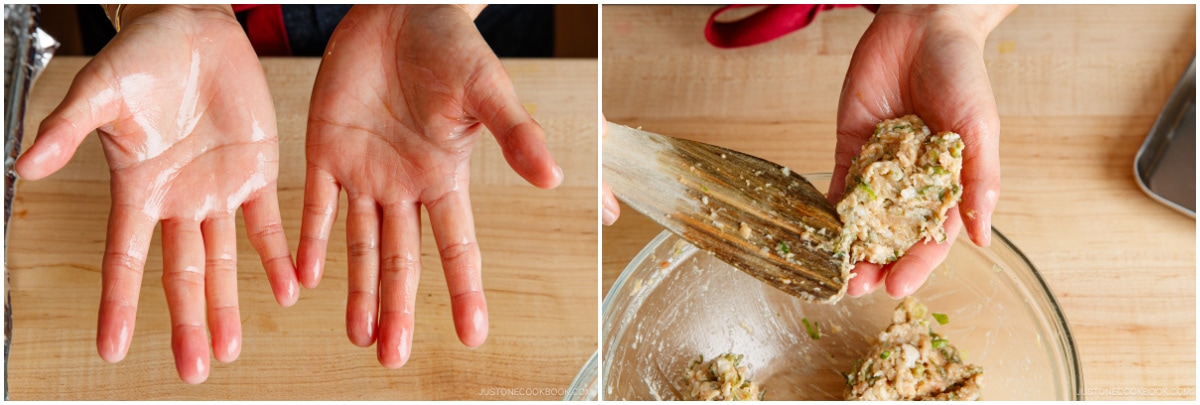
- Toss the meat back and forth between your hands to release the air pockets. Then, gently squeeze and shape the meat to form it into a long and oval patty, about 4 inches (10 cm) long.
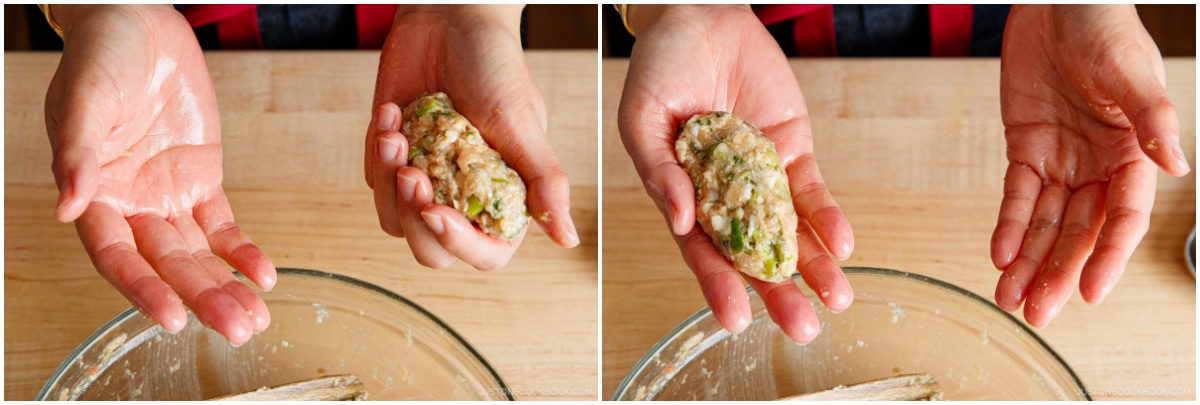
- Flatten the patty a bit. Now, place the top half to two-thirds of a skewer along the center line of the patty. Then, gently close the two sides of the patty around the skewer to encase the stick‘s tip and top part.
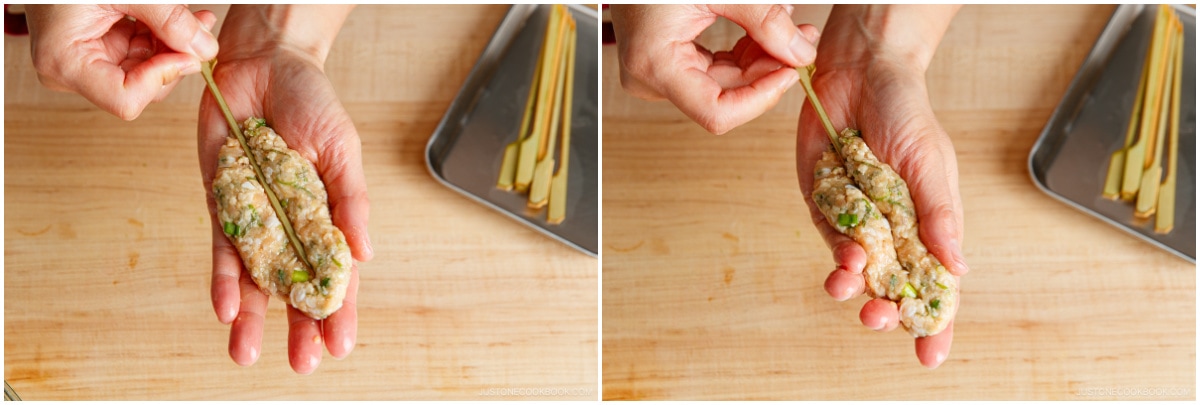
- Seal the edges of the patty together and form it again into a long, cylindrical shape. This thin shape allows the heat to penetrate the meat quickly.
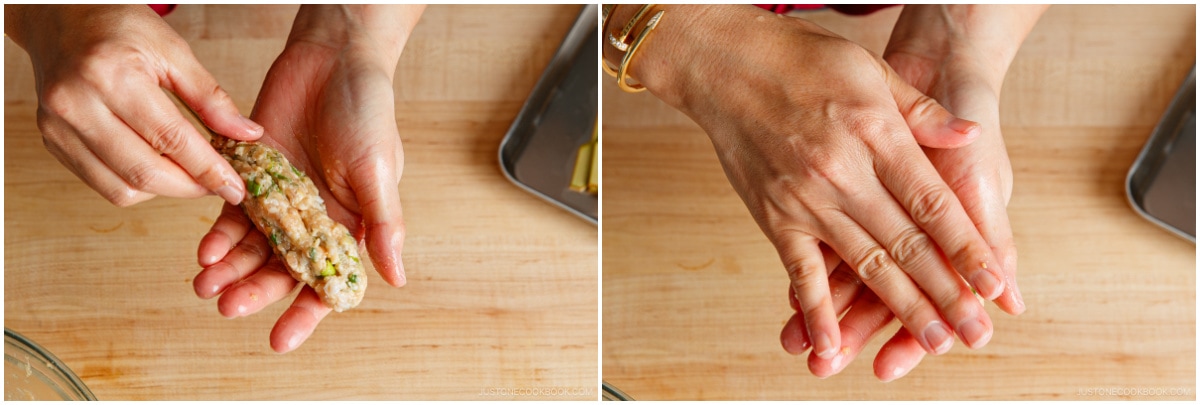
- Gently toss the skewered patty from one hand to the other a few times to make sure the front and back sides are nicely formed. Press and form the meat gently into shape.
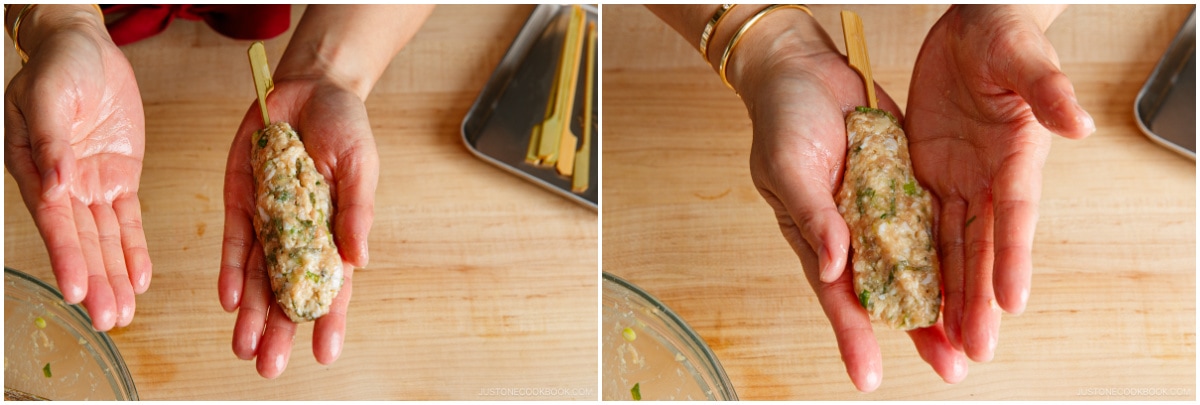
- Do a final check, making sure the skewer is secured in the center.
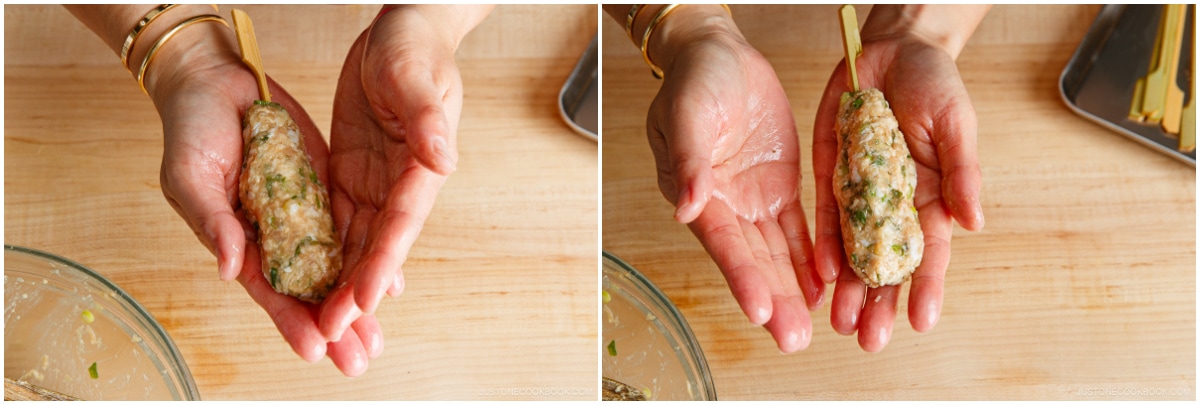
- Place the finished tsukune on the prepared wire rack, and repeat to shape the remaining tsukune. Space them apart on the rack and position them so the skewer handles line up along two of the rack‘s sides and the meat points toward the center. Lightly sprinkle coarse sea salt over the meat.
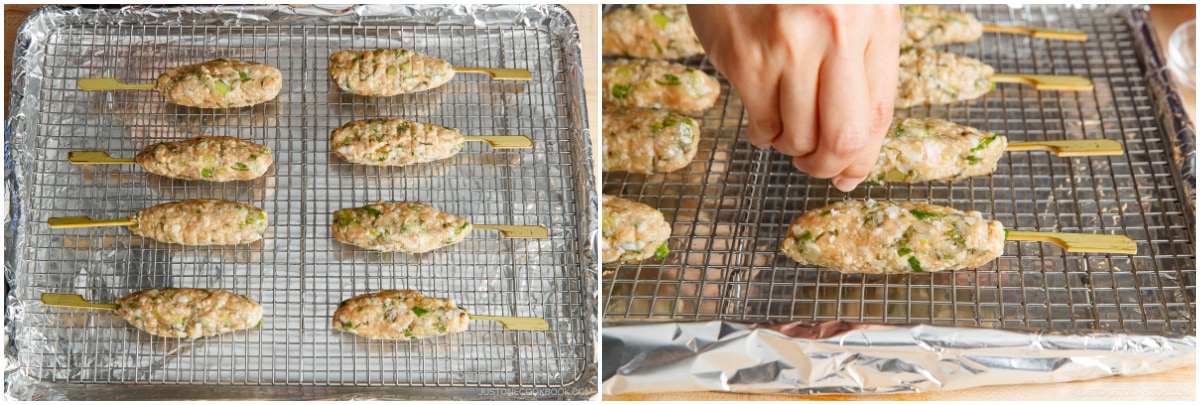
- Prepare strips of aluminum foil to cover the skewer handles and keep them from turning black and burning while broiling.
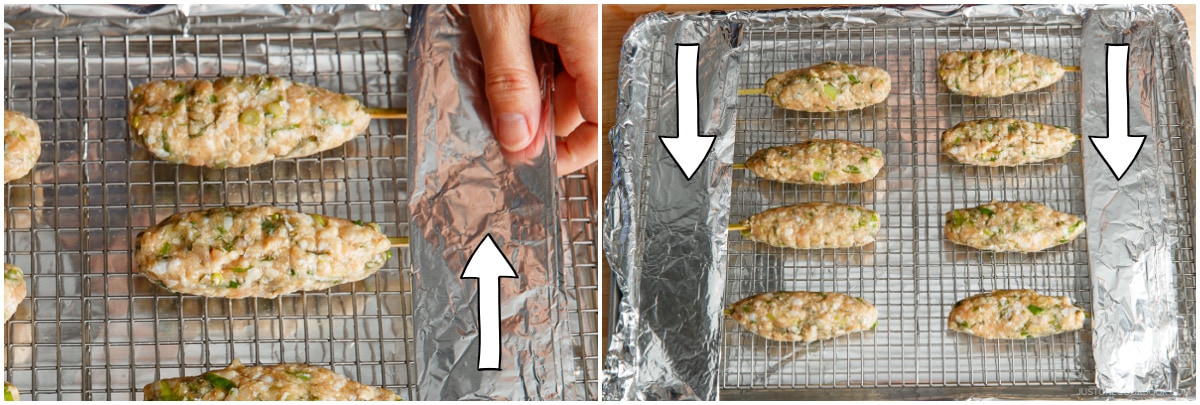
To Broil in the Oven
- Five minutes before cooking, preheat the oven broiler on High (550ºF/288ºC). After heating for 5 minutes, place the baking sheet on the middle rack of the oven, about 8 inches (20 cm) away from the heating element. Cook for 6 minutes. Watch the chicken closely while broiling so it doesn‘t burn. If your oven is small/strong, try broiling on Medium (500ºF/260ºC) or lower the rack. Tip: When broiling, you can‘t set the exact temperature. You adjust two things—the distance of the rack and the broiler settings (Low, Medium, or High). I usually use High and move the rack closer or farther away from the heating element.
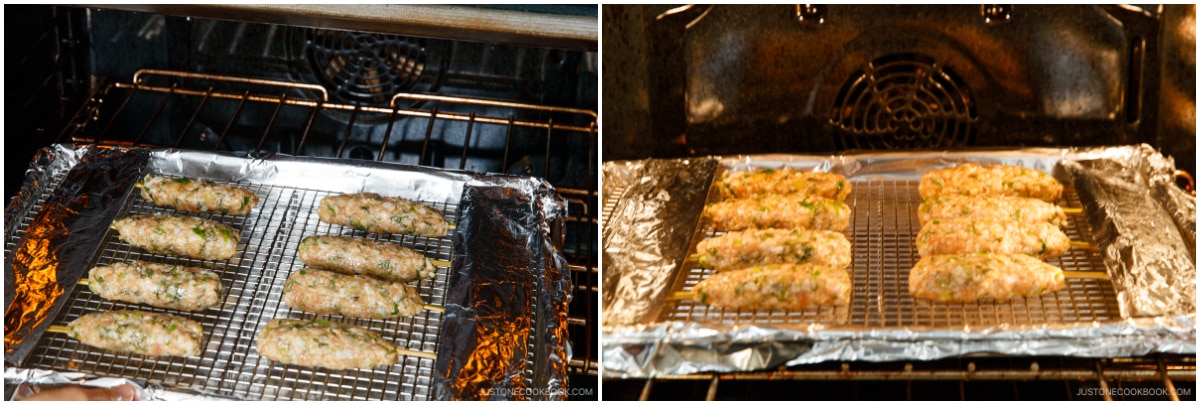
- Take out the baking sheet from the oven.
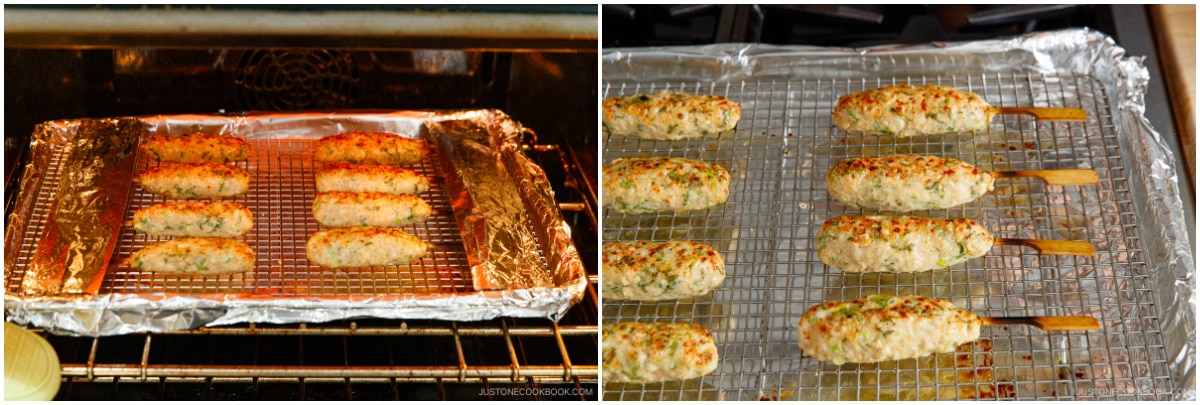
- Using a pair of tongs, flip the tsukune.
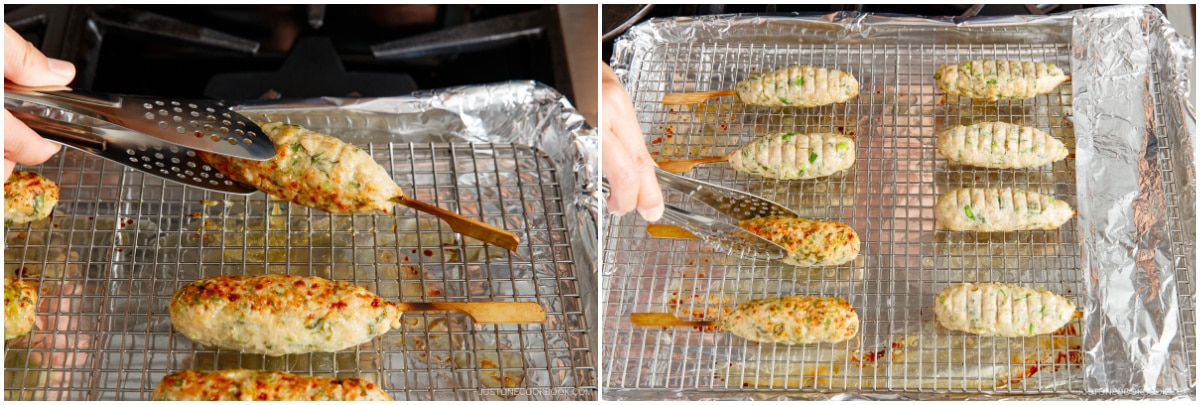
- Return the baking sheet to the oven and broil the other side for 4 minutes, or until the chicken‘s internal temperature is 165ºF (74ºC).
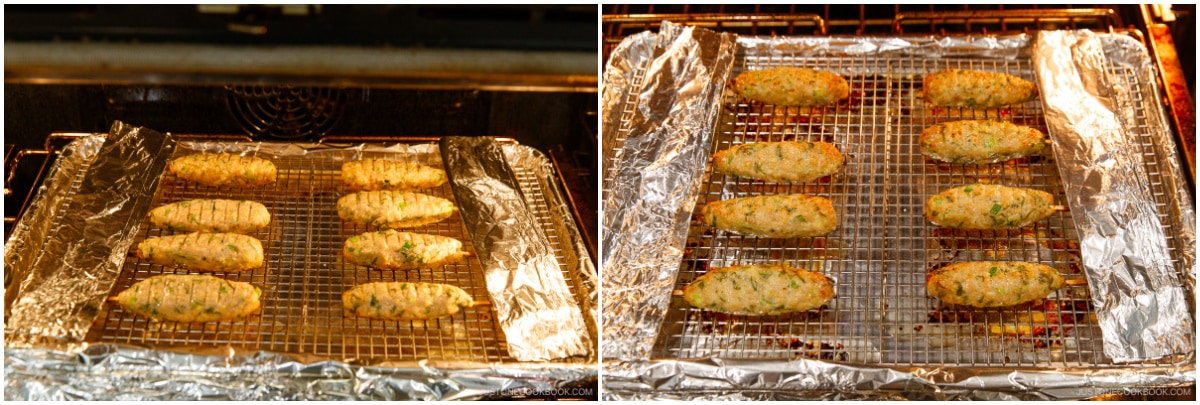
- When both sides are cooked, brush the yakitori sauce on the meat (I use a silicone brush). Broil for another 45–60 seconds to caramelize the sauce a bit.
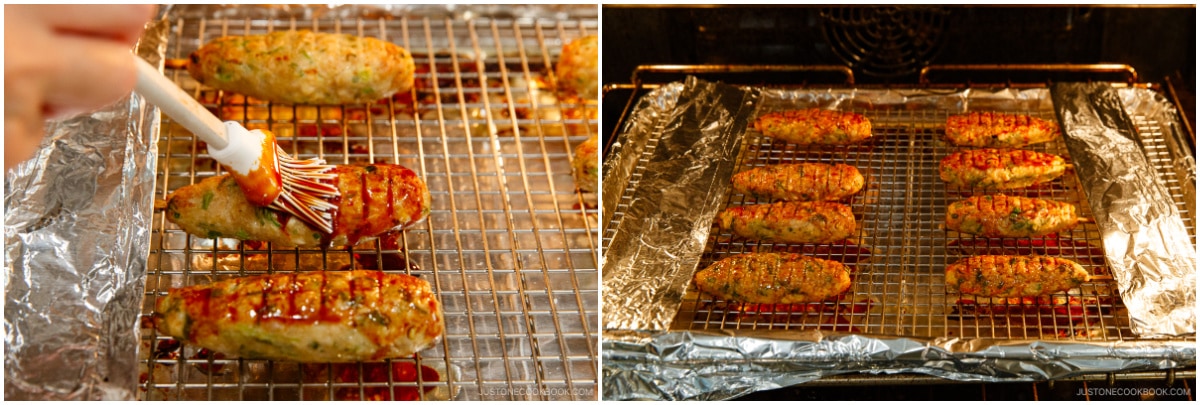
- Flip and brush the sauce on the other side of the meat and broil for another 45–60 seconds until sizzling.
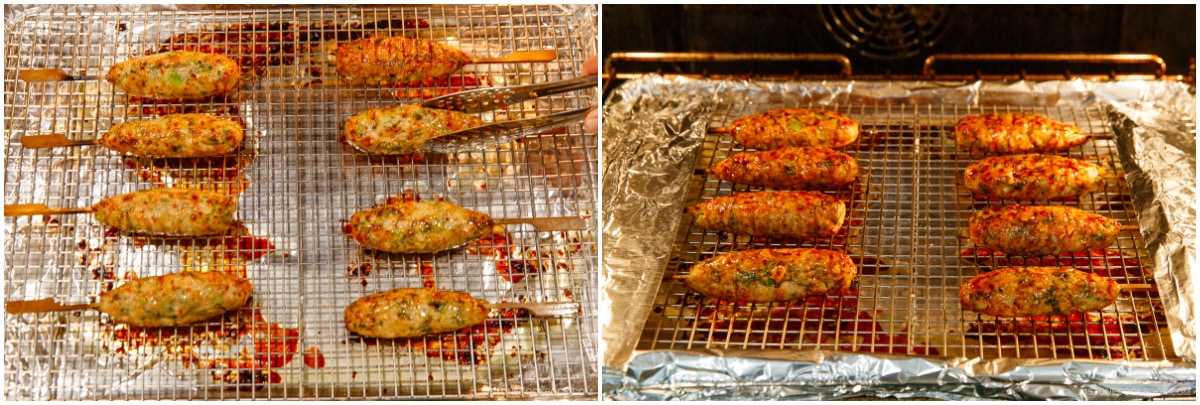
- Transfer the skewers to a serving plate and brush extra sauce on the meat. Serve immediately. Sprinkle optional shichimi togarashi (Japanese seven spice) for a spicy kick. You can try it dipped in Japanese Kewpie mayonnaise or yuzu kosho, too.
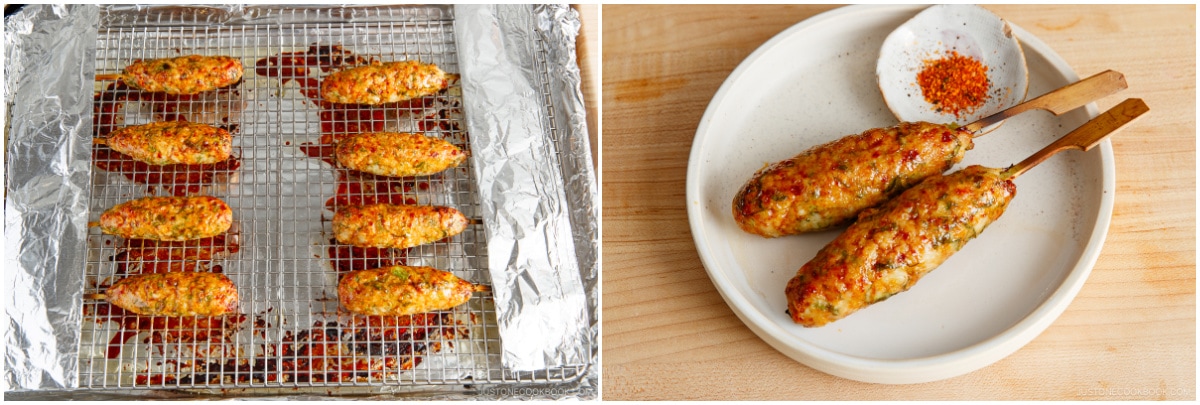
- In Japan, tsukune is often served with raw egg yolk (which is safe to consume in Japan). Optionally, dip in the raw egg yolk and enjoy!
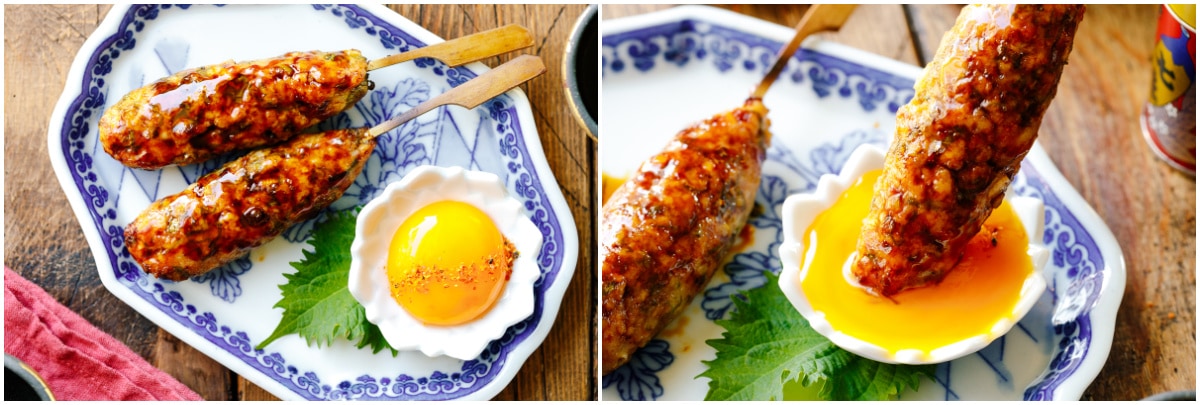
To Cook on the Grill (optional)
- Clean and grease the grilling grate. Preheat the grill to medium-hot heat, about 400ºF (200ºC). Gently place the skewers on the grill and cook until the bottom side is nicely brown, 3–4 minutes. With both a stainless steel spatula and tongs, gently rotate the tsukune and cook the other side for 2–3 minutes. Turn to the remaining sides where you want to grill more for another 1–2 minutes. To check if it‘s fully cooked, insert a bamboo skewer to see if the juices run clear or check that the chicken‘s internal temperature registers 165ºF (74ºC). Brush with additional yakitori sauce, cook briefly until sizzling, and remove from the heat.
To Store
- You can keep the leftovers in an airtight container and store in the refrigerator for up to 3 days and in the freezer for a month.
Nutrition
Editor’s Note: This post was originally published on June 2, 2014. It was republished with new images, a new video, and more helpful content on January 6, 2024.
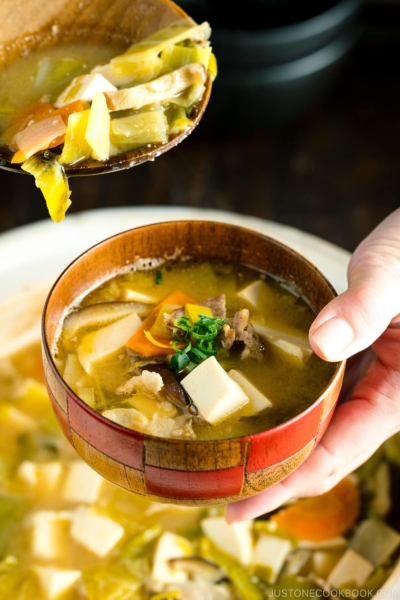
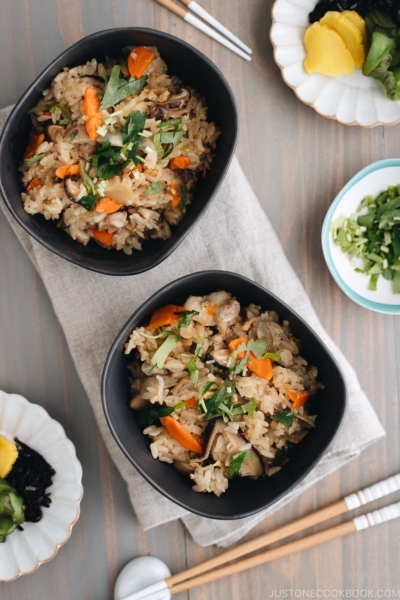
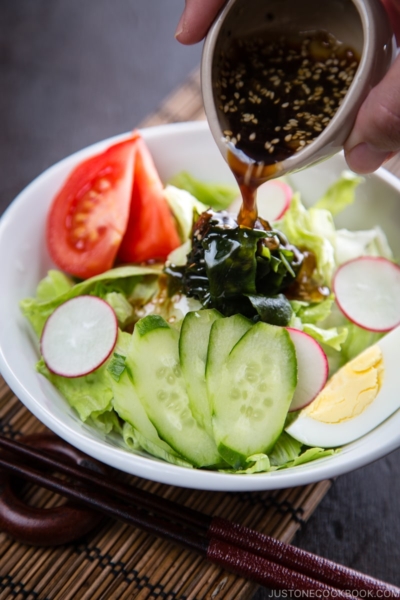
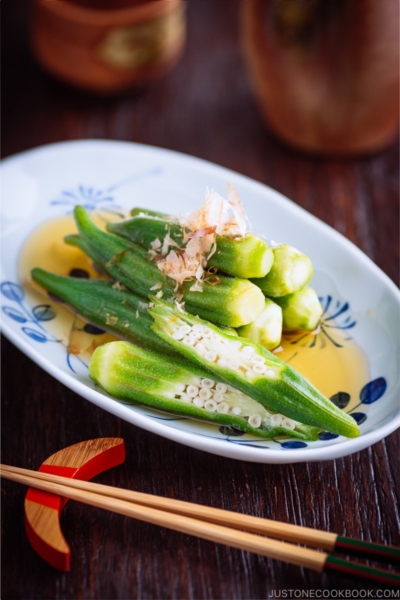
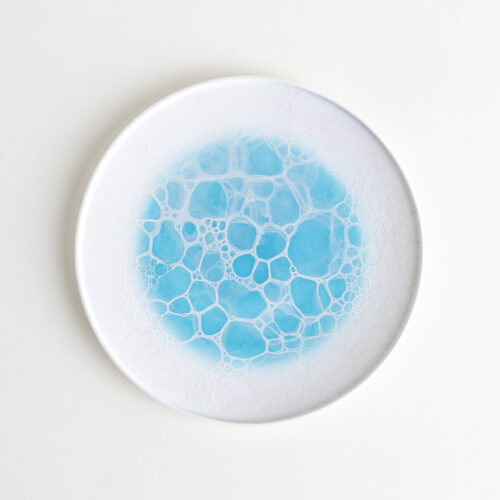
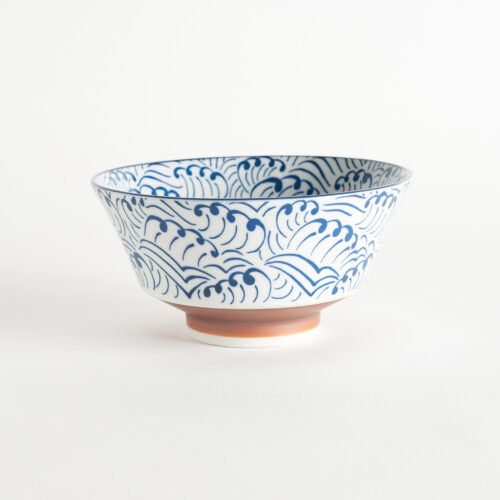
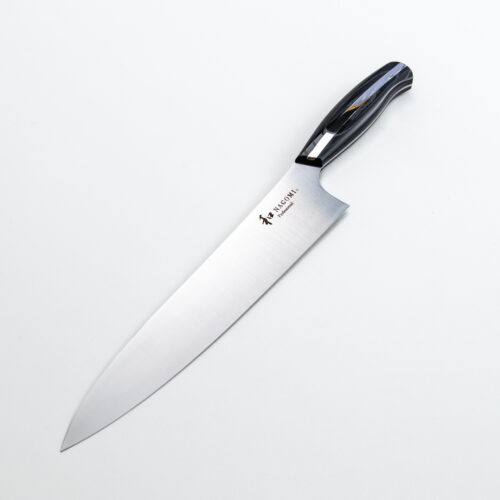
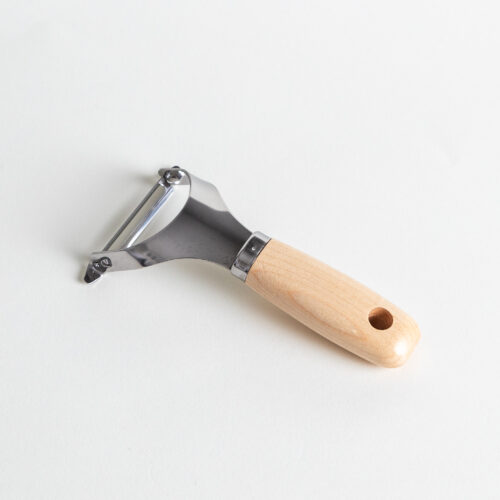

Hey! I wanted to know if I can make the meat mixture a day before and refrigerate it until cooking it the next day??
Hi, Bella! Thank you for trying Nami’s recipe.
We do not recommend storing raw meat mixtures. Instead, cook them and refrigerate for the next day. You can reheat it and brush it again with sauce. We hope this helps!
Hi Nami-have you tried to make the Tsukune in the air fryer? If so, how long and at what temperature? I’m making them tonight!
Hi Mika! Thank you for trying Nami’s recipe!
We have not tested this recipe in an air fryer, so we are not sure how it will turn out. However, most meatball recipes suggest cooking them at 400°F until the center of the meatball reaches 165°F. You can try cooking them for 12-14 minutes and see how they turn out. Please let us know how it goes if you decide to give it a try! 🙂
So I decided to prepare the tsukune under the broiler after all. The result? Pure deliciousness! Flavorful, succulent, and great served either warm or at room temperature. Kind of mendokusai (Japanese word for tedious) to make, but so WORTH IT! Yum!
Hi Mika! Arigato~🥰 Thank you for your update and your kind feedback!
We are glad to hear you enjoyed the outcome!
How long can I keep the unused yakitori sauce?
Hi Rachel! Thank you for trying Nami’s recipe!
You may keep it in the refrigerator for up to 2–3 months.
We hope this helps!
Just returned from Japan where we had amazing chicken meatball yakitori. Wanted to recreate the experience and used this recipe. Came out delicious!
Hi julie! Thank you so much for your kind feedback!
We are glad to hear Nami’s recipe worked well for you! Thank you for trying her recipe! 🤗
These are super delicious. I have tried around 10 differet recipies now and all have been amazing
Hi, Casper! Aww. We’re glad to hear you’re enjoying Nami’s recipes.🥰
Thank you for your kind feedback. Happy cooking!
Made these last week and they were great. Couldn’t find any decent looking shiso so just left it out. They were fine. So good that I made a double batch this week and took them to work for lunch. Namisan is right though…don’t skimp on the neading of the chicken and they will stay on the skewers just fine!
Hi Randy! Thank you so much for reading Nami’s post and trying her recipe!
We are so happy to hear you enjoyed the recipe, and Nami’s instructions helped.
Happy Cooking!🤗
Hi, Nami! This looks amazing! I really want to make this, but it’s really difficult to knead things for me because of an old injury. Would you recommend kneading the chicken on a stand mixer with the dough hook?
Hi, Danny! Thank you for reading Nami’s post.
Yes. The stand mixer with the dough hook should also work. Just be careful not to overknead because it is much stronger and faster than the hand.
We hope you will enjoy handmade Tsukune soon.😊
Hi. I’m thinking of making these to take to a potluck. How would I reheat them, or would they be good served cold / room temperature?
Hello, Ann. Thank you very much for trying Nami’s recipe!
This is also wonderful at room temperature, but we prefer to serve it warm so that the tsukune is juicy and fluffy. If you have access to a microwave, you can heat them before serving.
We hope this helped!
I take them to work and reheat in the microwave for lunch. Don’t overdo it though as they will get a little tough if you microwave them too long.
Awesome!
Hi! Can the tsukune be made without skewers and just meatballs in the air fryer? If so, what air fryer settings would you recommend? 🙂
Hello, Erin. Thank you for reading Nami’s post.
Yes, you can make this without skewers.
We have never tested this recipe in an air fryer, so we are unsure of the outcomes. However, most meatball recipes ask for cooking at 400°F until the meatball’s center reaches 165°F. So, try cooking for 12–14 minutes and see how things go. We hope this helps!🙂
Beautiful and simple recipe with chicken ground++ delicious and used leftover yakitori
Tare sauce. One of my favorite chef 🥰
Hi Kniom, We are glad to hear you enjoyed Nami’s recipe!
Thank you for trying her recipe and for your kind feedback.
Happy Cooking!
Can I make this ahead of time freeze until I’m
Ready to grill? If yes, Do I have to thaw before I grill?
Hi Maria! Thank you so much for reading Nami’s post and trying her recipe!
We do not recommend freezing the uncooked Tsukune. Instead, we recommend cooking it first and then freezing it for the best texture and flavor.
We hope this helps!
Hello, if i do not have miso, what is a suitable replacement?
Hi Kai! Thank you so much for reading Nami’s post and trying her recipe!
There is no appropriate substitute for miso, so to enhance the flavor, you may use ground ginger, garlic, or a dash of soy sauce.
We hope this helps!
Great recipe! Would metal skewers work well or should it only be bamboo? Thanks.
Hi John! Thank you very much for trying Nami’s recipe!
Sure, you can use metal skewers too.
We hope you enjoy Tsukune!
Hi! We made a batch. They were delicious. Then we made a second batch but added some Panko and some mixed seafood. I added a little more seasonings to make up for the increase in volume. They were delicious too. Your recipes are a hit in Dublin Ireland. Gerry,
Hi Gerard! We are so happy to hear you enjoyed the Tsukune!
Thank you very much for trying Nami’s recipe and sharing your cooking experience and tip with us.
Happy Cooking!
Can I pan fried these? I don’t have an oven or grill.
Hi Belle! Thank you very much for trying Nami’s recipe!
Sure, you can pan fry Tuskune or use this cooking method. https://www.justonecookbook.com/chicken-meatballs-with-sweet-and-sour-sauce/
We hope this helps!